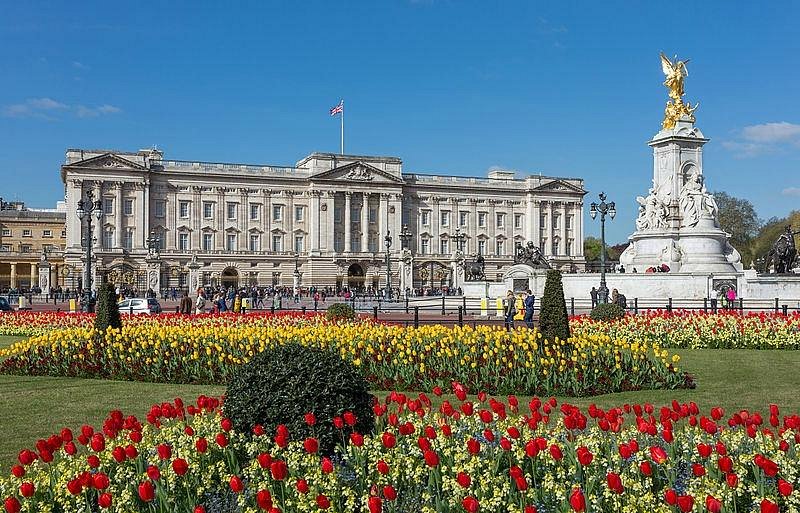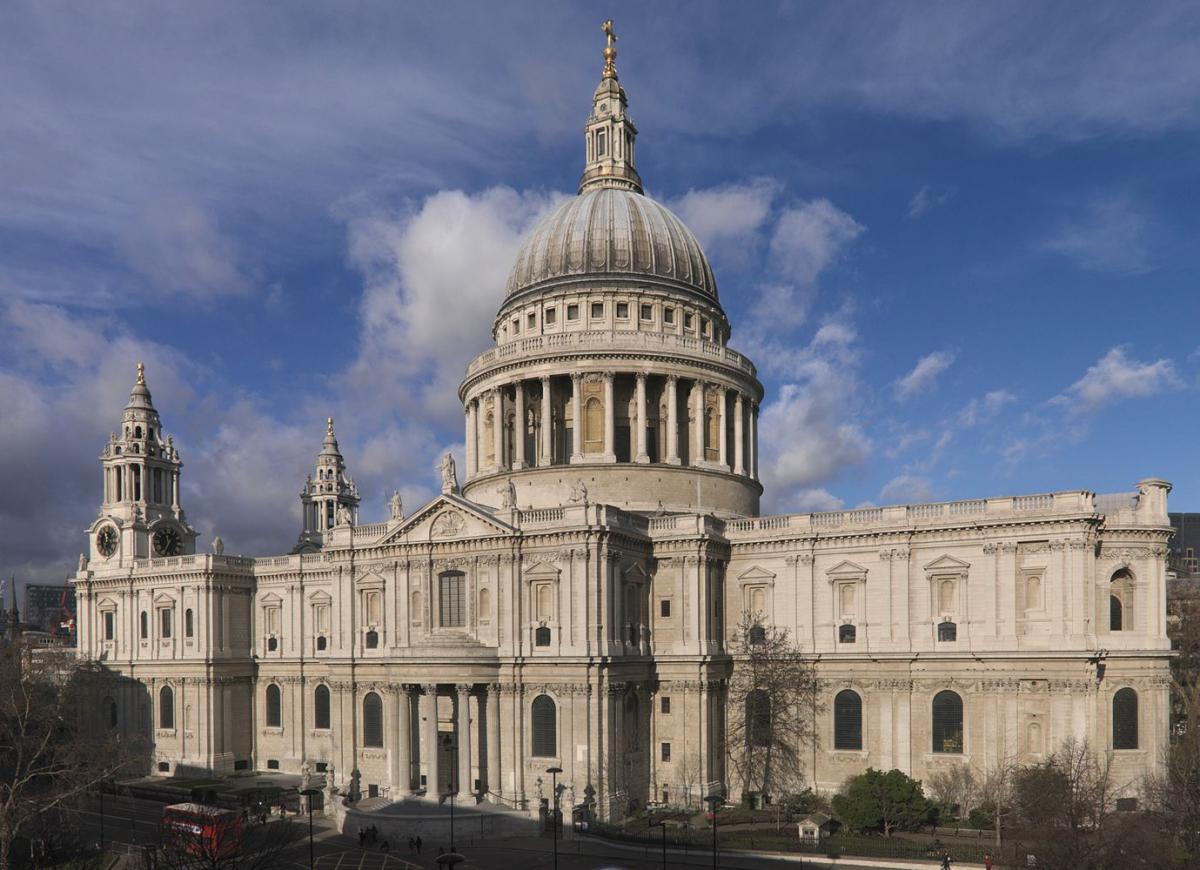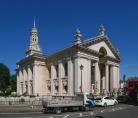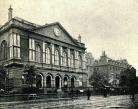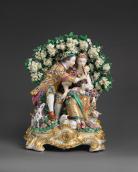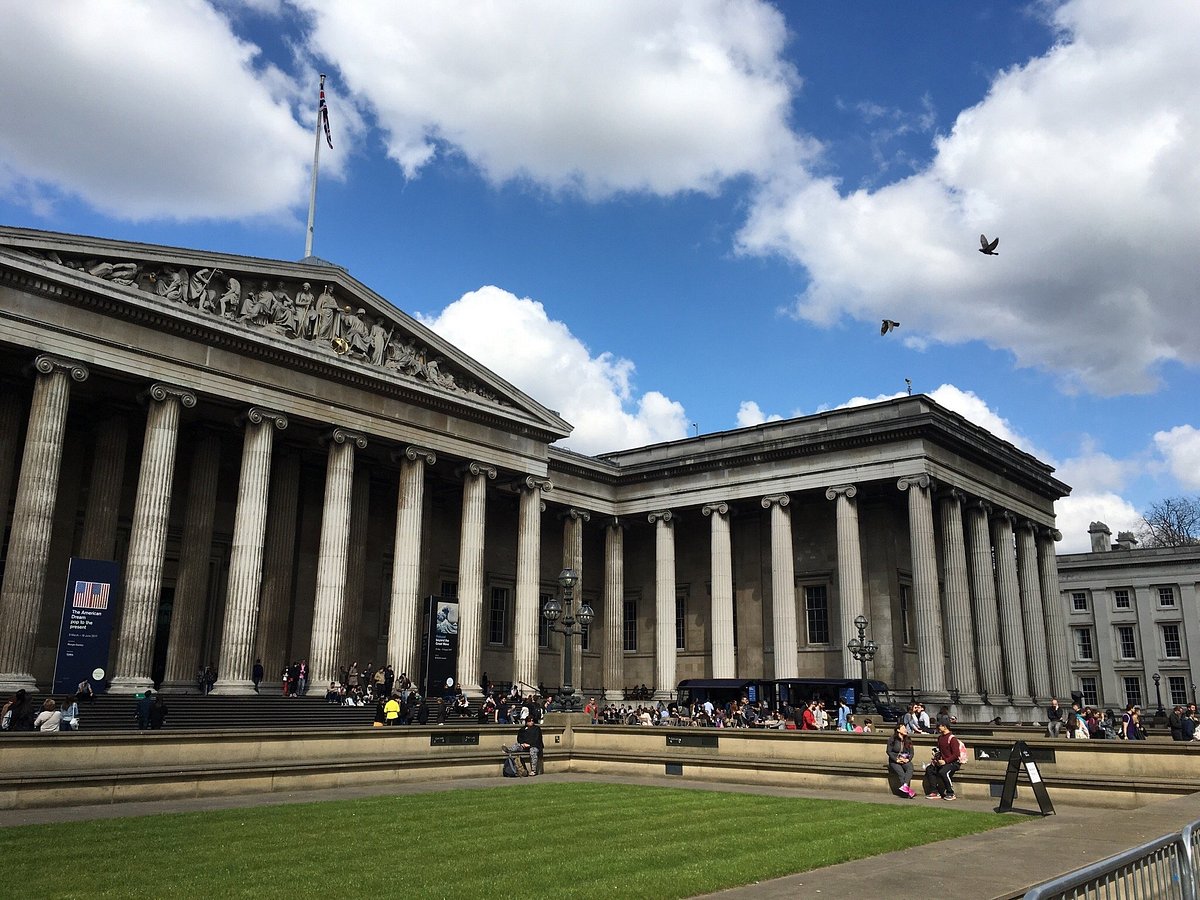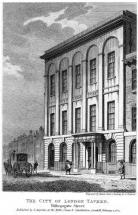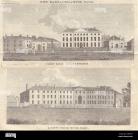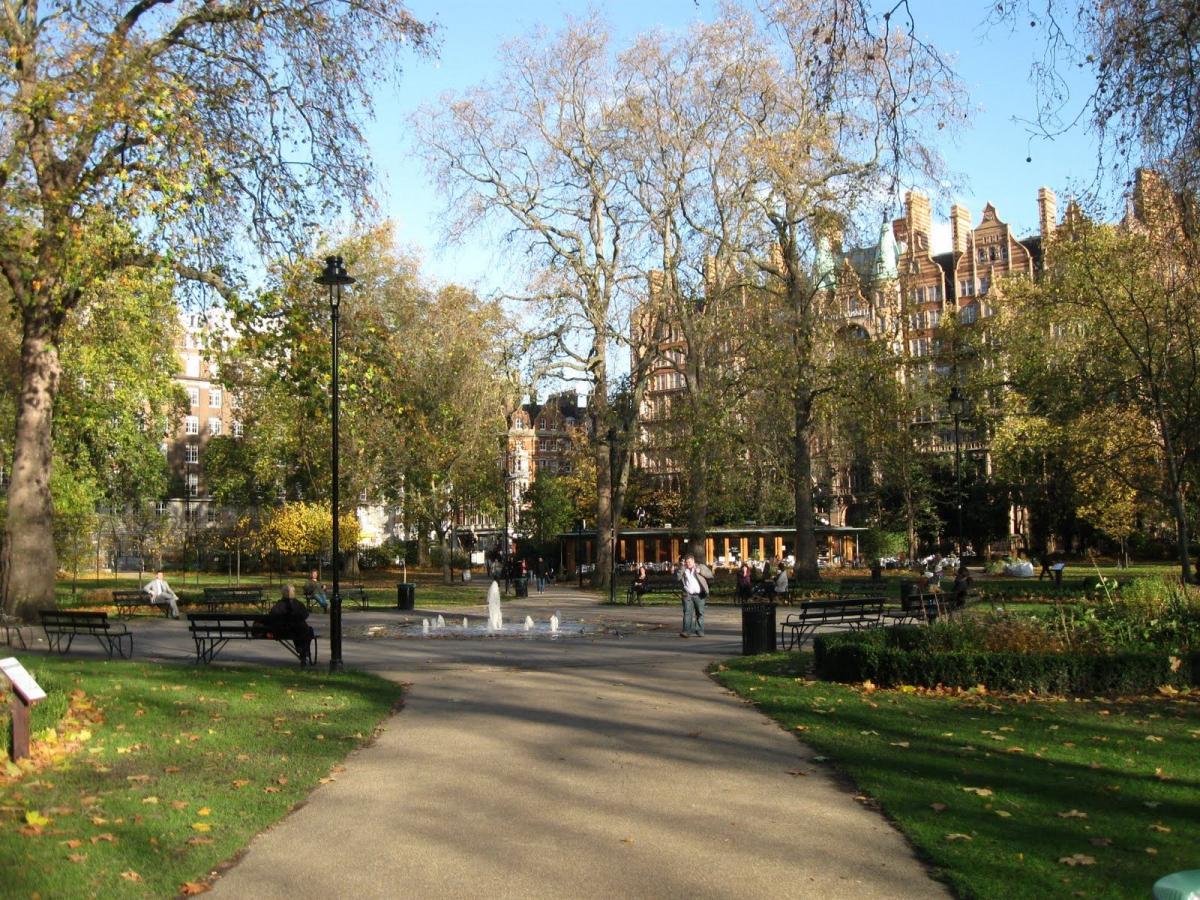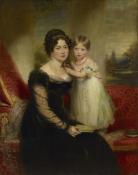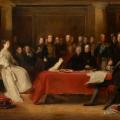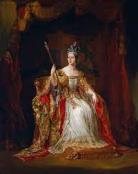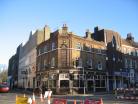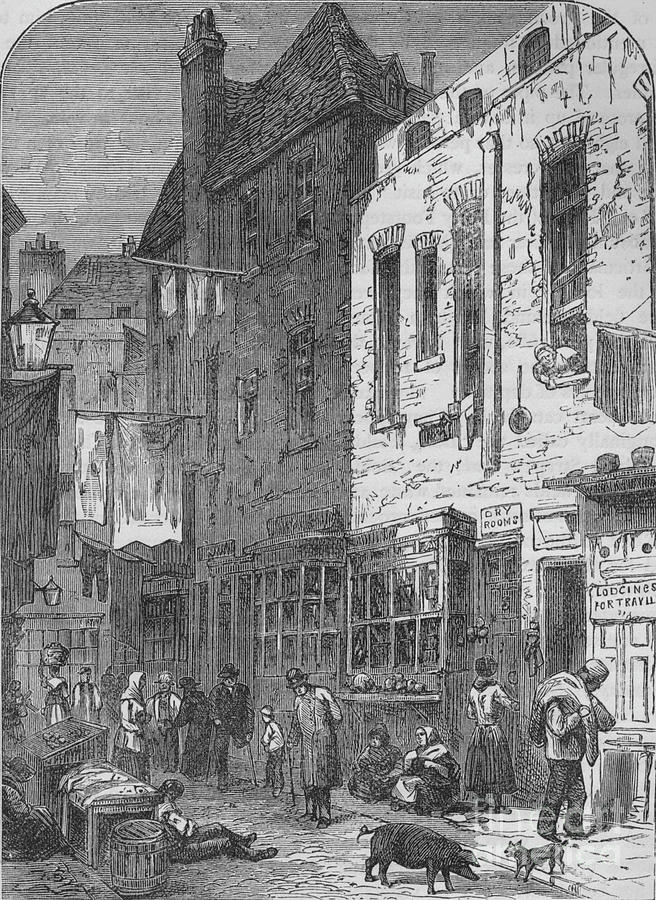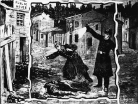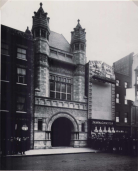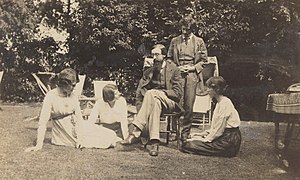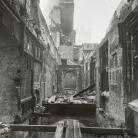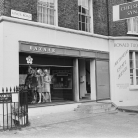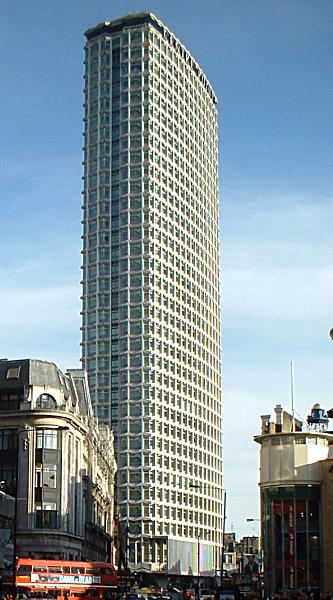London Calling CLASS TIMELINE!
Created by Laura Rotunno on Sat, 03/04/2023 - 12:04
Part of Group:
The site for all your interesting events from the locales you will investigate.
Timeline
Chronological table
| Date | Event | Created by | Associated Places | |
|---|---|---|---|---|
| 1600 to 1700 |
18th Century: The Rise of Kensington Palace as a Royal ResidenceIn the 18th century, Kensington Palace evolved into a significant royal residence, shaping the identity of what is now the Royal Borough of Kensington and Chelsea. Originally acquired by William III and Mary II in the late 1600s, the palace gained prominence during the early 1700s as it became the favored home of Queen Anne, King George I, and King George II. The 1700s saw architectural expansions, such as Sir Christopher Wren's extensions and Queen Caroline's redesign of the gardens, which helped transform the site into a symbol of British monarchy and statecraft. This development had a noticeable impact on the local population. With the presence of the royal court, aristocrats and members of high society began to build homes nearby, increasing the borough's wealth and prestige. The growth of this elite community also required an expansion of services, prompting migration of working-class individuals to the area to work as domestic staff, tradespeople, and servants. Though not wealthy themselves, these residents formed an essential backbone of the borough’s economy and social structure. The palace’s increasing political and cultural importance not only elevated the borough's profile but also marked a shift in royal power from central London to the western suburbs. This movement helped lay the groundwork for Kensington’s status as a high-profile residential and cultural area. "Kensington Palace." Historic Royal Palaces, www.hrp.org.uk/kensington-palace/. Accessed 21 Apr. 2025. |
Hailey Burchfield | ||
| 1700 to 1760 |
Neglect of Windsor Castle and It's RenovationThroughout the 18th Century, during the reigns of George I and George II, Windsor Castle experienced varying times of un-use and neglect. Both monarchs preferred other homes such as St. James’s, Kensington, or Hampton Court. These locations were more central to the city of London, as Windsor is more far removed (around 20 miles or so outside of the city). By staying close to the capital city of London, these monarchs claimed they were able to be more in tune with the latest social and political life of the city than they could have been at Windsor Castle. The early 1700s was a particularly important time in London’s history as The Bank of England was just founded in 1694. Obviously, from long periods of little to no occupation from the royal family, Windsor Castle experienced some neglect and disrepair, as well as the apartments generally falling out of the trends of the time. Some of the apartments were offered to friends of the Crown, but it was largely un-used. Additionally, during this time, the castle was opened for wealthy tourists who wanted to tour the inside of the castle, until eventually the general public was also able to take tours of the grounds and property. However, following the ascension of George III in 1760, this narrative changed. George III much rather preferred Windsor to any of the properties in London. He did some major renovations to the castle to help repair some of the aforementioned disrepair and outdated elements. He also purchased properties around Windsor such as the Royal Lodge in Windsor Great Park, which became a hunting lodge and country retreat for the royal family. George III would often go out of his way to remain in Windsor as much as possible, and his admiration for the town was reflected back at him. During his reign at Windsor, the children of the town were often seen playing on the grounds of the castle and King George III and his wife were often seen around the town doing their shopping. His love of Windsor set the scene for Queen Victoria to use it as her primary residence in the following century.
Ditchfield, William Page. “Windsor Castle: History | British History Online.” Www.british-History.ac.uk, 1923, www.british-history.ac.uk/vch/berks/vol3/pp5-29. Accessed 23 Apr. 2025. McQuillian, Kate. “The Legacy of King George III - College of St George.” College of St George, 29 Jan. 2020, www.stgeorges-windsor.org/image_of_the_month/the-legacy-of-king-george-iii/. Accessed 24 Apr. 2025. Royal Collection Trust. “Visiting Windsor Castle through the Centuries.” Www.rct.uk, www.rct.uk/visit/windsor-castle/visiting-windsor-castle-through-the-cent.... Accessed 23 Apr. 2025. Zatz, Sydney. “Windsor Castle: Its Origins as a Royal Residence - Royal Central.” Royal Central, 12 Mar. 2022, royalcentral.co.uk/features/windsor-castle-its-origins-as-a-royal-residence-173728/. Accessed 23 Apr. 2025. |
Noah Meckes | ||
| 1703 |
The building of Buckingham PalaceBuckingham Palace is the home and administrative headquarters of Britain's monarchs, originally built as a large townhouse for a duke in 1703. Since then, it has had an expansive history, where it turned from essentially a country home, to a 700-room palace. It was built by the Duke of Buckingham, and later purchased by King George the 3rd in 1762, for 28000 pounds. It was then given as a gift to Queen Charlotte in 1775.
The building was then renovated by George the Fourth, who never ended up living there. The first monarch who lived there was Queen Victoria. Even then it was not used as a proper, stable home and seat for the royalty, as it fell into disrepair. As time went on it was only used for ceremonies and balls. George the fifth and Queen Mary lived there in the 20th century, making it much more home-like.
It was also a victim of The Blitz, however it was used to celebrate the end of World War Two with the royal family and Winston Churchill.
At its current state it is home to over 700 rooms, including a cinema, swimming pool, post office, chapel, and even a surgery room. The upkeep and running of a building this size, along with its administrative purposes, requires over 600 employees. There are 760 windows. There are 350 clocks requiring two full-time clockmakers. There is a full-time fendersmith employed (clean and maintains fireplaces) - and there are 300 chimneys. The garden at Buckingham palace is 42 acres. That is about 31.8 football fields. This garden is home to a mulberry tree over 400 years old (1567). There is a museum on the grounds, and there is said to be over 10 million euros worth of art and antiques - not all of it on display. Sacyr. “Buckingham Palace's Hidden Secrets.” Sacyr Blog, 20 Oct. 2022, https://www.sacyr.com/en/-/los-secretos-que-esconde-el-palacio-de-buckin...
Vickers, Hugh. “The History of Buckingham Palace.” British Heritage, British Heritage, 13 Mar. 2023, https://britishheritage.com/history/history-buckingham-palace.
|
Kierra Weyandt | ||
| 1710 |
St. Paul's Cathedral and Its Audience
Because of The Great Fire in 1666 that destroyed approximately 13,500 houses and Old St. Paul’s Cathedral, and other priceless architecture, the 1700s were marked as a period of reconstruction and modernization of the previous medieval city. While the emphasis was placed on rebuilding the city, the displacement and new homelessness of London’s population were severe. Considering the fire occurred pre-insurance, a specific, The Fire Court, was designated for property disputes and financial hardships. The Great Fire led to today’s insurance industry. The New St. Paul’s Cathedral was constructed by architect Christopher Wren and consultations with the church. Today, it consists of baroque ornamentation with neo-gothic features such as Portland stone. The church reflected the shift from Catholicism to Protestantism. The church was completed in 1710. Wren oversaw the reconstruction of fifty-two churches In London, twenty-five of which have survived time. Inside the church there is a miniature and layout of Wren’s original design for the church as well as Wren’s gravestone which reads ‘ if you seek his memorial, look about you’. Wren experienced financial constraints for the rebuilding of the cathedral. Within the church, a Nigerian installation titled Still Standing by Victor Ehikhamenor rests next to a plaque that commemorates a British admiral that led the 1897 expedition to gather the African artifacts from the Benin Empire. Current discussion around the return of symbolic and stolen objects is debated, as the British have frequently sought out to control, displace, and capture artifacts from cultures/countries. Within the crypts of St. Paul, colonialism figureheads of the British Empire are housed. Including Horatio Nelson who frequented British occupied Honduras, Nicaragua, and Caicos Islands. This erasure and blatant celebration of the horrors of colonialism is, personally, one of the most striking features the cathedral has to offer. What privilege it must have been to pillage sacred symbols for display in St. Paul’s, a church that took thirty years to finish construction outliving several generations of children as 74% of children died before the age of five in London during the 1700s(“The History…).St. Paul’s Cathedral remains a social and political hub for reformers to ideally create a greater London. Davies, Sian. “Five Ways the Great Fire Changed London.” BBC News, BBC, 22 July 2016, https://www.bbc.com/news/uk-england-london-36774166. Jhala, Kabir. “Nigerian Installation in London's St Paul's Cathedral Provokes Debate around Restitution and Colonial Monuments.” The Art Newspaper - International Art News and Events, The Art Newspaper - International Art News and Events, 18 Feb. 2022, https://www.theartnewspaper.com/2022/02/17/nigerian-installation-in-lond.... “The History of London.” London's History, https://www.thehistoryoflondon.co.uk/in-brief-early-georgian-london/3/.
|
Hollie Keller | ||
| Sep 1718 |
The Construction of St Alfege ChurchDuring the Viking raids in England, one of the key positions that they would land on was in Greenwich. The army of the Danish was planted in Greenwich of well over 3 years and used it as a key position in raiding places like Kent and Canterbury. While raiding the British in Canterbury, the Vikings were able to capture Archbishop Alhpege and hold him for ransom against the nobility of England. However, Alphege refused to have his bounty paid and he was butchered by the Danish for his acts against them. Alphege became a martyr and was given sainthood in April of 1012. Many years later, the influence of the Catholics died down with the Protestant Reformation and several attacks against the Catholics in England. Before the death of Queen Anne in 1814, she passed a series of Acts that allowed for the construction of several Catholic churches and subsequently the Church of St. Alfege (Daniell). During the reign of Queen Anne and on, there was a certain level of Catholic influence that was present in the communities. Despite the history of London having a strong Protestant influence, the Queen Anne Acts proved that there was a sect of Catholics still in London as of the 18th century. Additionally, the church was built by Nicholas Hawksmoor by 1714, but it wouldn’t be consecrated until 1718. The church has the typical construction of most churches in England, but the rich history of the area and the name of the church is what make it unique. The church was even used during WWII as a bomb shelter that helped defend those in air raids. The church suffered internal damages from the bombing raids but still stands to this day. As of 1982, the church is no longer used for services and stands as a historical monument.
Sources: Daniell, Alfred Ernest, and Alexander Ansted. London Riverside Churches ... with 84 Illustrations by Alexander Ansted. Archibald Constable & Co., 1897. Ross, David. “Canterbury, St Alphege Church - History, Travel, and Accommodation Information.” Britain Express, https://www.britainexpress.com/attractions.htm?attraction=3372. |
Aidan Pellegrino | ||
| 1729 to 1730 |
St. Anne's Church LimehouseSt. Anne's Limehouse is a church in the Church of England built between 1714-1727 under the direction of an Act of parliament in 1711 (St. Anne's Limehouse). It was created as “St. Anne’s Limehouse” by the Limehouse Parish Act (1729) and officially consecrated in 1730 (Cryer). The idea was to serve a growing population of East London. Queen Anne, who had ordered the building of this church, decreed that the captains could register events that happened at sea since the church was not far from the River Thames. This same reason (being close to the Thames) is why the clocktower is the highest in London. Additionally, thanks to the special status afforded to this church as a registry of happenings on naval ships, it can fly the White Ensign of the British Navy all year round, which is a formal flag consisting of the Union Jack in an upper left corner and the St. George's cross (Munks). (This flag has a long history going back to the Tudors, which used to more colorful, but the colors changed to red, white, and blue. The White Ensign now looks the same as it did then, just that the cross is smaller in dimension (Jamieson, Zubova).) At the time, England and Scotland had joined together as the Kingdom of Great Britain, so building a church means that the Anglicans can reach more people to proselytize. The church serving as a place for naval captains to register events that occurred on their ships also supports the fledgling British Empire, which would soon have its footholds in the Indian Subcontinent, West Africa, North America, and the Caribbean. The people working in Poplar would likely have been white ethnics (Irish, Italians, Eastern Europeans) or people of color (British History Online), and non-Protestants or non-Christians who would be doing domestic work (nannying, cooking, laundry), manual labor (building ships, unloading ships, etc.), or other types of labor that didn’t pay well, which entrenched the cycle of poverty into the East End.
Cryer, A.B. “St. Anne’s Limehouse Explained.” Everything Explained Today, n.d., https://everything.explained.today/St_Anne%27s_Limehouse/. Jamieson, Kate. “History of the Naval Ensign.” The Trafalgar Way, 17 Oct. 2019, https://www.thetrafalgarway.org/blog/history-of-the-naval-ensign. Munks, Holly. Photograph of St. Anne’s Limehouse, showing the clocktower. Poplarlondon.co.uk, n.d., https://poplarlondon.co.uk/st-anne-s-church-limehouse-history/. Munks, Holly. “Watching over Limehouse: the secret history of St Anne’s Church.” Poplar LDN, 21 May 2024, https://poplarlondon.co.uk/st-anne-s-church-limehouse-history/. "Pennyfields". Survey of London: Volumes 43 and 44, Poplar, Blackwall and Isle of Dogs. Ed. Hermione Hobhouse (London, 1994), British History Online. Web. 24 April 2025. https://www.british-history.ac.uk/survey-london/vols43-4/pp111-113. “St. Anne’s Limehouse.” St. Anne’s Limehouse [organization], n.d., https://web.archive.org/web/20141222162558/http://stanneslimehouse.org/history.html. Zubova, Xenia. “The White Ensign: A brief history of the iconic Royal Navy flag.” Forces News, 2 Sep. 2022, https://www.forcesnews.com/services/navy/white-ensign-brief-history-iconic-royal-navy-flag. |
Paige McCusker | ||
| 1740 |
Antiquarian Interest and Early DocumentationIn the mid-eighteenth century, a pioneering antiquarian by the name of William Stukeley published "Stonehenge: A Temple Restor’d to the British Druids." In this book, Stukeley believed Stonehenge was a temple built by ancient Druids, who were the priestly class of the Celtic people, long before Rome conquered Britain. He saw the monument as part of a sacred landscape, aligned with solar and celestial events, and argued that the layout of the stones had religious and symbolic meaning, particularly in relation to nature and the sun. Notably, he even described the site as resembling a serpent form when mapped out with nearby earthworks, thus interpreting the whole area as a kind of Druidic cosmological diagram. Though it is now known in modern times that Stonehenge predates the Druids by at least a thousand years, Stukeley’s work was enormously influential in associating Stonehenge to spiritual and mystical ideas as he was among the first in history to study and document the site. His detailed drawings and measurements helped preserve knowledge of Stonehenge during a time when the site was deteriorating and overlooked. Prior to his contributions, it was uncommon for people to excavate the earth looking for artifacts or prior civilizations as a means to learn more about history. Thus, Stukeley was a pioneer figure in what is British Archaeology today (Neale). Besides being one of the first serious antiquarians, William Stukeley was a noteworthy figure in British history. Early in his life, he showed interest in mapmaking and sketching, which would come in handy later in life, but worked in his father’s law firm soon after school. Realizing he was not interested in his father’s career, he attended Corpus Christi College in Cambridge to primarily study medicine, but also became interested in botany, natural philosophy, antiquities, and astronomy. Upon graduating, he went to London to learn more about the medical field and later practiced medicine in Lincolnshire. Interestingly, one of the friends he made along the way was Sir Isaac Newton. Stukeley was the first to write a biography about Newton and witnessed the apple falling from a tree that sparked the theory of gravity. Years later, Stukeley stopping practicing medicine and was ordained in the Church of England, ultimately enabling him to study the religious and historical aspects of Stonehenge (Neale). The surrounding area of Stonehenge, Wiltshire, was largely rural, made up of farmers, shepherds, and laborers in the eighteenth century. Most people living near Stonehenge were part of an economy in which they relied on agriculture, had limited access to education, and wouldn’t have understood the significance of Stonehenge the way educated elites did. There were no tourist facilities or protections for the site at the time, and locals sometimes took stones for building material or allowed livestock to roam among them. There was little sense of “preservation” as the ancient monuments were seen more as curiosities or nuisances than as national treasures (“Wiltshire”).
Sources
Neale, Fiona. “William Stukeley’s Stonehenge.” University of Glasgow Library Blog, 7, Nov. 2015, https://universityofglasgowlibrary.wordpress.com/2015/11/07/william-stuk...'s%20studies%20had%20convinced%20him,which%20had%20since%20become%20lost.
“Wiltshire.” Encyclopedia Britannica. https://www.britannica.com/place/Wiltshire. |
Layna Henry | ||
| 1740 |
The London Infirmary opensSince its founding in the autumn of 1740, the Royal London Hospital, initially known as The London Infirmary and then The London Hospital, has been one of the most extensive charities of its kind. According to its website, its aim was “the relief of all sick and diseased persons and, in particular, manufacturers, seamen in the merchant service and their wives and children". As such, it gave much-needed aid to those who needed it the most, i.e. the lower-class individuals that often made their home in the Whitechapel area. |
Logan Wertz | ||
| 1742 to 1762 |
James Bradley’s Work at the Royal ObservatoryA site of importance as “Britain’s oldest purpose-built scientific institution,” Greenwich’s Royal Observatory, located in Greenwich Park, celebrates its 350th anniversary in June 2025. King Charles II ordered the creation of the Royal Observatory to advance knowledge in navigation and astronomy, focusing on the study of longitude to increase safety in sea travel. As sea trade was imperative for the economy and relations between countries, it was important to ensure that sailors, ships, and their goods remained safe and knowledgeable about their position while on the seas. The architects built the observatory upon the old Greenwich Castle as that land already belonged to the British monarchy and the land was secluded yet close enough to London (“History of the Royal Observatory”).
James Bradley was the third Astronomer Royal in 1742-1762 who had made over 60,000 observations in this time frame. The title Astronomer Royal, created by King Charles II, is treated as an honor given to renowned astronomers that advise the crown in matters of astronomy (“The Astronomer Royal”). Astronomy work ran in his family as his uncle, Reverend James Pound, was a leading astronomical observer in England with a connection to second Astronomer Royal Edmond Halley, whom they both worked with. He was best known for two discoveries: the aberration of light, “which produces an apparent motion of celestial bodies about their true positions,” and the nutation of the Earth's axis, the variation over time of the axis of rotation’s orientation, caused by gravitational forces (Falconer et al.). Bradley’s observations “are the earliest from anywhere in the world whose accuracy and consistency is such, that are still of use to astronomers today” (Dolan).
During his time as an Astronomer Royal, he also worked on observing the moon and Jupiter, updating the equipment at the Observatory, and defined the Bradley meridian used in the Ordnance Survey (“James Bradley”). His work helped lead to the world’s inclusion of the Greenwich Meridian and Greenwich Mean Time. Unfortunately, none of his observations were published until 1798, aside from two published by Edmond Halley in 1718.
Works Cited: Dolan, Graham. “The Royal Observatory Greenwich – A Brief History.” The Royal Observatory Greenwich, The Royal Observatory Greenwich, 2014, http://www.royalobservatorygreenwich.org/articles.php?article=1 Falconer, I.J.; Mena, J. G.; O’Connor, J.J.; Peres, T.S.C.; & Robertson, E.F. “James Bradley.” MacTutor, 2018, https://mathshistory.st-andrews.ac.uk/Biographies/Bradley/#:~:text=Bradley%20was%20best%20known%20for,the%20velocity%20of%20the%20observer “History of the Royal Observatory.” Royal Museums Greenwich, https://www.rmg.co.uk/royal-observatory/history “James Bradley.” Royal Museums Greenwich, https://www.rmg.co.uk/collections/objects/rmgc-object-203215 “The Astronomer Royal.” Royal Museums Greenwich, https://www.rmg.co.uk/stories/topics/astronomer-royal Wilson, Benjamin. James Bradley. ca. 1750, National Maritime Museum, Greenwich, London |
Emera Gregor | ||
| 1745 |
Chelsea Porcelain Factory FoundedIn the 18th century suburb of Chelsea, the Chelsea Porcelain Manufactory created some of the finest pieces of British porcelain. The factory, founded by Frenchmen Nicholas Sprimont and Charles Gouyn, catered to wealthy Londoners. Being founded by two Frenchmen is symbolic of the large French population in the area, as many Huguenots chose to settle in the city and specifically in that area. Chelsea China was produced at 16 Lawrence Street, Chelsea from 1745 to 1784. The area of Chelsea was a fashionable area, a trait that would continue for the area’s history. Notions of class and wealth have proved to be key areas of discussion for much of the area’s history, as even today there is notable wealth inequality. Boucher, François. The Music Lesson. ca. 1765. The Met. https://www.metmuseum.org/art/collection/search/203386. Accessed 18 April 2023. “Chelsea Porcelain Manufactory: Finch: British, Chelsea.” The Metropolitan Museum of Art, https://www.metmuseum.org/art/collection/search/658952. Accessed 18 April 2023. |
Kathryn Maille | ||
| 1753 |
The Establishment of the British MuseumIn 1753, an Act of Parliament created the world's first free, national, and public museum: the British Museum, located in Bloomsbury, London. The current collection of artifacts in the British Museum consists of around 8 million items that span across 2 million years of human history, although only 1% (80,000) of the objects are on public display. One of the largest contributors to this collection was Sir Hans Sloane. He was known as a collector of artifacts from around the world. Upon his death in 1753, he gifted his collection of over 80,000 “natural and artificial rarities” to Great Britain. Thus, the Sir Hans Sloane collection became what is considered the founding collection of the British Museum. These items also became the foundation of the British Library and the Natural History Museum. The British Museum’s collection was originally housed in the 17th century mansion, Montagu House. It was refurbished multiple times before and after the museum became open to the public in 1759 to make room for the massive collection. However, more room was still needed to hold the British Museum collection, so in 1823 the Montagu House was demolished. In its place came the museum that we know today, Sir Robert Smirke’s enormous Greek Revival style building. This new home for the British Museum collection was completed in 1852. The British Museum’s building and artifact collection are both being expanded and developed to this day. Sources: “History.” The British Museum, https://www.britishmuseum.org/about-us/british-museum-story/history “Sir Hans Sloane.” The British Museum, https://www.britishmuseum.org/about-us/british-museum-story/sir-hans-sloane “Fact Sheet - British Museum.” The British Museum , https://www.britishmuseum.org/sites/default/files/2019-10/fact_sheet_bm_collection.pdf
|
Margaret Wetzel | ||
| 1754 |
Kenwood House is purchased by the 1st Earl of MansfieldKenwood House, estimated to have been originally built in 1616 and was home to the Earls of Mansfeild. It was later demolished and rebuilt by the Surveyor-General of the Ordnance, William Bridges and sold in 1704 and shifted many owners until the Earl of Mansfield, William Murray, purchased it in 1754. In 1764, Murray commissioned Robert Adam to remodel the house for him. He added the most iconic and well-known area of the house: the library. It was donated to the London City Council and opened to the public in 1927 as a museum of sorts.
In mid-1790, the house was ransacked as part of the Gordon Riots. While most of the rioters just stole food, many items such as mirrors and paintings were ransacked as well. Murray and his wife fled the house during this time, which allowed the ransacking of the space. The Gordon Riots took place in London over several days to protest anti-catholic sentiments. The riots were a response to the Popery Act of 1698 which enforced stricter laws onto the British people. Kenwood was just one of the casualties of the Riots, as British Banks and Prisons were targeted too.
After Murray’s death in 1793, Kenwood was inherited by his son, David Murray the 2nd Earl of Mansfeild. It was passed down for generations until the 6th Earl of Mansfielddecided to sell it in 1906 and leased it to the exiled Grand Duke Michael Mikhailovich of Russia. It was finally bought in 1922 by the Kenwood Preservation council and opened to the public as it contains many historical and art pieces.
Today, Kenwood still contains paintings like Self Portrait with Two Circles, by Rembrandt, along with many other classical pieces. It is currently under the ownership of the Friends of Kenwood and The English Heritage Trust. Work Cited “Friends of Kenwood Archive .” Friends_of_Kenwood, 20 Oct. 2019, https://web.archive.org/web/20191020115019/http://www.friendsofkenwood.o.... Accessed 18 Feb. 2023. “Kenwood.” English Heritage, https://www.english-heritage.org.uk/visit/places/kenwood/?utm_source=awi.... Accessed 18 Feb. 2023. “Kenwood House front with extensions.” 27 Nov. 2005 https://commons.wikimedia.org/wiki/File:Kenwood_House_front_with_extensions_2005.jpg Accessed 18 Feb. 2023. “Kenwood House (Iveagh Bequest), Non Civil Parish - 1379242: Historic England.” , Non Civil Parish - 1379242 | Historic England, https://historicengland.org.uk/listing/the-list/list-entry/1379242. Accessed 18 Feb 2023.
|
Allison Schroeder | ||
| 1760 to 1760 |
The Demolition of Bishopsgate (Bishop's Gate)In 1760, the medieval Bishop's Gate, one of the original entrances through the London Wall into the City, was demolished as part of broader urban modernization efforts. The gate, named for its historical association with the Bishop of London, had stood since at least the Roman era and had been rebuilt several times over the centuries. Its removal reflected a shift in London's urban priorities, from defense and to a freer movement and trade. As London's population grew and inevitably commerce expanded, old city gates were increasingly seen as impediments to traffic and development. The demolition of Bishop’s Gate, now known as Bishopsgate, was both practical and symbolic: it represented the city's evolution from medieval stronghold to a center of global commerce and enlightenment-era civic planning (Weinreb et al. 2008; Schofield 1994). Porter, Roy. London: A Social History. Harvard University Press, 1995. Accessed April 23, 2025 Schofield, John. The Building of London: From the Conquest to the Great Fire. Sutton Publishing, 1994. Accessed April 23,2025 Weinreb, Ben, et al. The London Encyclopaedia. 3rd ed., Macmillan, 2008. Accessed April 23, 2025 |
Hollie Keller | ||
| Sep 1768 |
Opening of the London TavernDuring the 18th century, London was home to many coaching inns and taverns that served as places of rest for travelers. Bishopsgate and surrounding regions were ideal spots for such inns, as, upon the popularization of stagecoach travel in the 17th century, travelers often entered through Bishop’s Gate, an old Roman entrance to the city (McLachlan). One notable inn from this period is the London Tavern, built in September 1768 on the former site of the White Lion Tavern, which had been destroyed in a fire three years prior. The London Tavern notably featured a large dining room with ornate Corinthian columns and other elaborate ornamentation. According to the contemporary account of John Timbs in his Club Life of London, Vol. II, this dining room could hold at least 300 dinner guests for banquets (274). Timbs also further elaborates on the tavern’s decoration, writing, “The walls are throughout hung with paintings; and the large room has an organ,” (274). Even shortly after its opening, the London Tavern was the site of numerous important meetings and events. In 1769, for instance, around 400 men formed the Society of the Supporters of the Bill of Rights in the London Tavern (Cash 249). The Society was dedicated to supporting John Wilkes, a controversial member of parliament who championed the individual rights of people associated with the American Revolution and who introduced the first ever motion in the House of Commons to allow for the voting rights of all adult males (Cash 2). Another London Tavern meeting of historical importance is that of the Revolution Society, a group sympathetic to the ideals of the French Revolution that celebrated the cause of the Glorious Revolution, which met in the tavern in 1789 shortly after the fall of the Bastille (Abstract of History 8). In the subsequent century, the London Tavern was also visited by Charles Dickens, who presided over a meeting there in 1841 for the benefit of the Sanatorium for Sick Authors and Artists, and who also attended another dinner there in 1851 for the General Theatrical Fund (“London Tavern”). The London Tavern also makes a direct appearance in Dicken’s novel Nicholas Nickleby (Dickens).
Abstract of the History and Proceedings of the Revolution Society, in London. Revolution Society, 1790, https://archive.org/details/bim_eighteenth-century_an-abstract-of-the-histo_revolution-society-lond_1790/mode/2up. Pamphlet. Cash, Arthur H. John Wilkes: The Scandalous Father of Civil Liberty. Yale University Press, 2007. Dickens, Charles. The Life and Adventures of Nicholas Nickleby, 1839. Project Gutenberg, 2016. Engraving of the London Tavern in 1809. Wikipedia, 1809. https://d245m47bicpi64.cloudfront.net/_imager/files/Activities/Archives/46476/WR-3_36ec1335269ad97502c26586ba96154b.png. Accessed 17 Apr. 2023. “The London Tavern.” The Worshipful Company of Bowyers, https://www.bowyers.com/meetingPlaces_londonTavern.php. Accessed 17 Apr. 2023. McLachlan, Sean. “Travel Through Time at England’s Coaching Inns.” British Heritage Travel, 10 Apr. 2023, https://britishheritage.com/travel/travel-englands-coaching-inns. Accessed 17 Apr. 2023. Timbs, John. Club Life of London, Vol. II. Richard Bentley, 1866. |
Travis Saylor | ||
| 2 Jun 1780 to 9 Jun 1780 |
The Gordon RiotsThe Gordon Riots of 1780 serve as some of the most violent pieces of recorded Westminster history, displaying the horrid effects of intersecting religion and politics, or church and state in 18th-century England. The riots began as an aggressively anti-Catholic response to the Catholic Relief Act (Papists Act) of 1778. The Catholic Relief Act aimed to cut back on the discrimination against Roman Catholics, allowing these individuals to join the army and own property, among other basic rights. However, the Protestants did not agree with this new way of life, as they viewed Roman Catholics as being a threat to Britain’s identity. The leader of the Protestant Association, Lord George Gordon, became the face of this backlash, acting as a voice for the Protestants who decided that Catholics would now be able to infiltrate the military and commit treason. All of the anger and backlash from the Protestants culminated on June 2nd, 1780. Nearly 60,000 of the protestors gathered in St. George’s fields, then were led to Parliament by Gordon himself to present to them a petition to repeal the Catholic Relief Act. The main idea to keep in mind is the fact that the confrontation started out peacefully. However, this peace was short-lived. Their demonstration quickly turned extremely violent, with members of Parliament being attacked, Catholic churches and homes being targeted, etc. Over the following few days, the chaos only got worse. June 7th of the same year came to be known as “Black Wednesday,” due to the sheer amount of dark violence brought on by the rioters. Prisons such as Newgate were burned to the ground, freeing prisoners and harming others, and the Bank of England was nearly stormed, leading King George III to declare martial law on the country. By that Friday, the riots had ended, but not without significant loss. Aside from the damages caused by looting and arson, it is estimated that 300 people lost their lives in the short time span. Luckily, some justice was brought to these people, as about 450 rioters were arrested afterward, with 25 of them being hanged. As for Lord Gordon himself, he was sentenced to eight years in prison and was tried for high treason, though acquitted as they could not hold him solely responsible for the rioters’ actions. In the end, the Gordon riots displayed to the public the sheer scope of violence that can occur when civilians band together. They proved to the country that effective law enforcement is crucial, and they starkly underlined class tensions in Great Britain, where issues of religion, government, and social class intersected harshly. These riots serve us today as a clear example of a time in history not worth repeating. Resources: “Spotlight on: Gordon Riots.” The National Archives, The National Archives, 28 Mar. 2025, www.nationalarchives.gov.uk/education/students/videos/spotlight-on/spotlight-on-gordon-riots/. “The Gordon Riots: How an Anti-Catholic Petition Escalated into the Most Destructive Riots in London’s History.” HistoryExtra, HistoryExtra, 20 Aug. 2024, www.historyextra.com/period/georgian/gordon-riots/#. “The Gordon Riots: London in Flames.” London Walks, www.walks.com/blog/gordon-riots-london. “History of the Gordon Riots.” EBSCO Research Starters, www.ebsco.com/research-starters/history/gordon-riots. Gresham College. “The Gordon Riots of 1780: London in Flames, a Nation in Ruins.” Gresham College, www.gresham.ac.uk/watch-now/gordon-riots-1780-london-flames-nation-ruins. “Gordon Riots.” Wikipedia, https://en.wikipedia.org/wiki/Gordon_Riots |
Amelia Vachon | ||
| circa. The start of the month Summer 1780 to circa. The start of the month Summer 1780 |
The Closing of The Clink (18th century)The Clink is known as the "most notorious medieval prison"; is also one of the oldest and was in use from 1144 to 1780. The conditions for prisoners here were absolutely horrendous, and most were there because they had debts they couldn't pay. But the prison was originally for heretics. They were all often subject to grueling torture and rooms that regularly flooded, causing bodies to rot from not being able to dry. The clink had two distinct sections, one for men and the other for women. The only way for prisoners to get relief from the torture is if they were lucky enough to have someone on the outside to give money as a bribe to the jailors. These bribes could also bring them more comfortable amenities and food during their stay. Usage of this prison decreased as the years passed, but it was always a loathed place for many. Then in 1780, The Clink was broken into during the Gordon Riots, which were led by Anti-Catholic Protestant Lord Geroge Gordon. That night the rioters freed all prisoners that were still in The Clink before setting the whole thing ablaze. The Click was not ever rebuilt or used again after those riots, and many, if not all, escaped prisoners were not captured again. Today there is a Clink museum in the same spot in Southwark where the prison was originally, but all that still stands from the original is one brick wall. The Clink Museum. The Rich and Gory History of the Clink Prison. clink.co.uk/history-of-clink.html The British Library. Map of the Gordon Riots. www.bl.uk/learning/timeline/item104674.html Ian Haywood. The Gordon Riots of 1780: London in Flames, a Nation in ruins. Grahamn College. March 11, 2013
|
Danielle West-Habjanetz | ||
| 1791 |
Camden TownAs Camden Town and the greater Borough of Camden itself started out as barely a grouping of a few houses alongside a main road, it was not until much later that they gained their names after their namesake, Sir Charles Pratt, the first Earl of Camden. Sir Pratt obtained the area of Camden Town through marriage in 1791, specifically the land that was once upon a time the manor of Kentish Town, but death claimed the man just three years later, in 1794. While the Borough of Camden did not become established until much later on April 1st, 1965, Camden Town slowly began to grow in popularity over the years. As the world made progress with the industrial revolution during the 19th century and railways and canals were built through the location and became adapted to serve a transportation function, they also brought with them new life. Still, Camden Town was deemed an unfashionable area until change struck again in 1973, when the old warehouses and similar buildings were transformed to serve as tourist destinations. It still contains a significant number of methods of transportation throughout in order to accommodate the large amount of tourism in the area, simply having switched over from shipping goods to transporting people over the years. Areas like the Camden Catacombs, which were initially built for the transportation of goods (and not to serve as an underground cemetery as the name would suggest) but could not be converted into stores or walkways due to public safety concerns, were either closed off to tourists or became submerged below the water level. Having housed a variety of popular figures over the years as well, Camden Town has made many appearances in various forms of media and is now a well-known name to those even outside of London.
“Camden Town.” Wikipedia, Wikimedia Foundation, 27 Apr. 2025, en.wikipedia.org/wiki/Camden_Town |
Sophia Girol | ||
| 1795 |
Construction of Barracks in KnightsbridgeIn the 1700s, Knightsbridge was a very different place from what it is now. All throughout the 18th century, Knightsbridge was in very early stages of development with very few new buildings and unpaved, unlit streets, which is a very stark contrast to the Knightsbridge of today. However, following the French Revolution, tensions were high and the threat of soldiers being corrupted by revolutionary influences were very high. Following urban riots in 1792, the government decided the best course of action would be to build barracks in an effort to isolate the soldiers and slow the threat of revolutionary influence on them, so they built a new set of barracks in Knightsbridge. These barracks were quite different from past calvary barracks that had been constructed throughout the years in Britain.
"Knightsbridge Barracks: The First Barracks, 1792-1877." Survey of London: Volume 45, Knightsbridge. Ed. John Greenacombe. London: London County Council, 2000. 64-68. British History Online. Web. 18 April 2023. http://www.british-history.ac.uk/survey-london/vol45/pp64-68. |
Noah Meckes | ||
| 1801 |
Establishment of Russell SquareRussell Square was established in 1801 by Francis Russell, the fifth Duke of Bedford. He commissioned James Burton, the most successful developer at the time, to design and construct the buildings. Russell square was the centerpiece of Russell’s development plan for Bloomsbury to increase economic activity. This plan was extremely successful. Russell Square was the largest square in London at the time, and one of the most desirable places to live in. Not only was Russell Square built in Bloomsbury, the intellectual and literary capital of London, but the square is also within walking distance of The British Museum and Oxford Street. Russell Square quickly became home to the highest of society. Some of the famous residents of Russell Square include the influential poets Thomas Grey, William Cowper, and T.S. Eliot. After the establishment of Russell Square in 1801, Bloomsbury became filled with countless scientists and artists, as shown in Michael Boulter’s novel, “Bloomsbury Scientists." Sources: “Russell Square.” Hidden London, https://hidden-london.com/gazetteer/russell-square/. “Russell Square.” Bloomsbury Squares & Gardens, 30 Nov. 2021, https://bloomsburysquares.com/the-squares/russell-square/. Trimatis, Killian. “A Brief History of Bloomsbury.” TripTide, https://triptide.london/journals/bloomsbury-history. Boulter, Michael. Bloomsbury Scientists PDF. https://discovery.ucl.ac.uk/id/eprint/1573504/1/Bloomsbury-Scientists.pdf.
|
Margaret Wetzel | ||
| 1802 |
The Regent's CanalThe Regent’s Canal, first brought up in a proposal in 1802, did not begin its actual construction until October 14th, 1812. After many years of labor, the canal was finally opened in all its glory on August 1st, 1820. However, the first section, which stretches from Paddington to Camden Town, was opened to the public in 1816, facilitating early transport and commerce in the area. Spanning a total length of 8.6 miles, the Regent’s Canal serves as a vital link between the Paddington Arm of the Grand Union Canal and the Limehouse Basin and the River Thames. The canal played a crucial role in propelling Camden headfirst into the industrial revolution, which was later further amplified in the area by the addition of the North Western Railway’s terminal stop in Camden in 1837. These developments not only boosted local trade but also transformed Camden into a bustling hub of industrial activity and, eventually, tourism. As the years went by and the canal’s use began to shift from mainly shipping goods over greater distances to transporting people locally, the Central Electricity Generating Board decided to install underground cables below the towpath between St John’s Wood and City Road in 1979, forming part of the National Grid that supplies electrical power to London by using the canal water as a coolant for the high-voltage cables and keeping the dangerous and unsightly equipemnt out of the way of the population in the area. In an act to celebrate its 200th anniversary, not too long ago in 2012, the playwright Rob Inglis was awarded a substantial grant in order to fund the creation of the musical Regent’s Canal, a Folk Opera in its honor, celebrating the digging of the canal and all the location has done for the area of Camden and also London overall.
“Regent’s Canal.” Wikipedia, Wikimedia Foundation, 9 Mar. 2025, en.wikipedia.org/wiki/Regent%27s_Canal |
Sophia Girol | ||
| 1802 |
East/West India DocksThe West and East India Docks would be built in 1802 for unloading cargo from both companies: spices from India (East India Company); and the occasional enslaved person, as well as goods like rum, sugar, and cotton from the British West Indies (Encyclopedia Britannica). These were the two companies that expanded the British Empire's reach. The Poplar Docks would've connected to the West India Docks to serve as a reservoir. Then it was converted into a timber pond (1844) and into a railway dock (1850-1851) to move coal around and export other goods (British History Online). As mentioned above, the East India Company in particular served as the hand of the British Empire, not only getting in on the spice trade in India, but then partaking in the Transatlantic Slave Trade, in which they transported people from Africa to India and Indonesia, as well as to the Caribbean and the Southern United States (Alabama, Florida, Georgia) along the Middle Passage (Encyclopedia Britannica). India in particular would find itself completely kneecapped by the colonization of the British. India was effectively entirely conquered by the 1820s and supplying the Empire with raw materials like cotton, silk, saltpeter for gunpowder (Encyclopedia Britannica). During this time, there would be an influx of immigrants from overseas who were poor. They would follow typical immigration patterns seen around the world - Irish, Eastern European, then Chinese, Indian, etc. - and work in occupations like bricklaying, factory work, unloading docks, servitude, etc. Around the 1880s would be an influx of Chinese, Japanese, and Lascar (from Somaliland, Indian Subcontinent, Arab World, Southeast Asia) immigrants, who would land in the Pennyfields section of Poplar and expand out as more and more people of that heritage worked on British ships. They would also build opium dens or brothels (British History Online).
Daniell, William. An Elevated View of the New Docks & Warehouses now constructing on the Isle of Dogs near Limehouse for the reception & accommodation of Shipping in the West India Trade. 1802. The British Museum, https://www.britishmuseum.org/collection/object/P_G-13-17. Accessed 20 Apr. 2025. Editors, Encyclopedia Britannica. “East India Company.” Encyclopedia Britannica, 23 Jan. 2020, https://web.archive.org/web/20200910045538mp_/https://www.britannica.com/topic/East-India-Company. Accessed 20 Apr. 2025. Editors, Encyclopedia Britannica. "India - Colonialism, Mughal Empire, Trade | Britannica." Encyclopedia Britannica, upd. 24 Apr. 2025, https://www.britannica.com/place/India/The-British-1600-1740. Accessed 24 Apr. 2025. "Pennyfields". Survey of London: Volumes 43 and 44, Poplar, Blackwall and Isle of Dogs. Ed. Hermione Hobhouse (London, 1994), British History Online. Web. 24 April 2025. https://www.british-history.ac.uk/survey-london/vols43-4/pp111-113. Accessed 24 Apr. 2025. "Poplar Dock: Historical development". Survey of London: Volumes 43 and 44, Poplar, Blackwall and Isle of Dogs. Ed. Hermione Hobhouse (London, 1994), British History Online. Web. 21 April 2025. https://www.british-history.ac.uk/survey-london/vols43-4/pp336-341. Accessed 23 Apr. 2025. |
Paige McCusker | ||
| 17 Oct 1814 |
The St. Giles Beer FloodThe London Beer Flood occurred on October 17th, 1814 when the pressure from a 1 million pint beer barrel exploded in the Meux & Co's Horse Shoe Brewery, causing many other barrels to break and begin to flood the brewery, into the streets. Around 570 liquid tons of beer crashed into other barrels quickly flooding the brewery. The force of the explosion caused the bricks of the building to collapse and flood St. Giles neighborhoods, killing eight people.
The clerk in charge of maintenance that day was George Crick, who survived the flood. He noticed a broken 700- pound hoop on the barrel that had slipped off and decided to let another employee fix it the next day. Before long the barrel had exploded from the pressure, covering the St. Giles Neighborhood in mere minutes. Despite his negligence, the clerk and the brewery were cleared of any wrongdoing by a jury and declared that the caulsties lost their lives by an “act of God,” and that they had died “casually, accidentally and by misfortune.” All of the people inside the brewery survived.
Anne Saville was one of the casualties, along with four other people mourning the loss of her two year old son at his wake near to the brewery. The people of St. Giles took to the streets, wading through nearly two feet of beer, in search of people who survived by climbing onto furniture.
The flood occurred in St. Giles which was a parish of Holbourn that would later form the Borough of Camden. The brewery stood on the corner of Tottenham Court Road, and became an attraction after the flood for a short period of time. Watchmen would charge two-pence for people to see the rubble of the accident. The Brewery would suffer an economic loss, but received a break on the taxes that they had already paid the government.
Works Cited “Horseshoe Brewery, London, c. 1800.jpg.” 15 Feb. 1906. https://commons.wikimedia.org/wiki/File:Horseshoe_Brewery,_London,_c._1800.jpg Accessed 18 Feb. 2023. KLEIN, CHRISTOPHER. “The London Beer Flood.” History.com, A&E Television Networks, 9 Oct. 2019, https://www.history.com/news/london-beer-flood. Accessed 18 Feb. 2023. Tingle, Rory. “What Really Happened in the London Beer Flood 200 Years Ago?” The Independent, Independent Digital News and Media, 17 Oct. 2014, https://www.independent.co.uk/life-style/food-and-drink/features/what-re.... Accessed 18 Feb. 2023. |
Allison Schroeder | ||
| 24 May 1819 |
Queen Victoria is Born in 1819On May 24, 1819, Alexandrina Victoria was born in the dining room of Kensington Palace amid the “baby race” of the potential succession crisis looming of the late 1810s, delivered by the same woman who also delivered her first cousin and future husband Albert. She grew up in Kensington Palace as well, provided with many talented teachers and tutors but restricted under the “Kensington System.” She resented the restrictive nature of the system’s rules imposed on her by her mother and Sir John Conroy, whom her mother depended on after her husband and Victoria’s father died. Despite this, she was able to tour the country and was seen as a new hope for the country as she was not associated with the negative parts of the dynasty. In the early morning of 20 June 1837, she learned she was then Queen Victoria, as her uncle, the king, had died.
Wilkie, David. Victoria, Duchess of Kent, (1786-1861) with Princess Victoria, (1819-1901). 1821. Royal Collection. https://www.rct.uk/collection/407169/victoria-duchess-of-kent-1786-1861-with-princess-victoria-1819-1901. Accessed 18 April 2023. Wilkie, David. The First Council of Queen Victoria. 1838. Royal Collection. https://www.rct.uk/collection/404710/the-first-council-of-queen-victoria. Accessed 18 April 2023. “Growth of a Victorian Suburb.” The Royal Borough of Kensington and Chelsea, https://www.rbkc.gov.uk/vmhistory/general/vm_hs_p10.asp. Accessed 18 April 2023. |
Kathryn Maille | ||
| 16 Oct 1834 to 16 Oct 1834 |
The Burning of the Houses of ParliamentThe burning of the Houses of Parliament on October 16, 1834, was one of the most notable events that occurred in 19th-century England. The fire destroyed centuries of architectural history and represented the fall of their old political structure, as well as the rise of a new, more modern one. The fire began due to a seemingly mundane act: the Exchequer (treasury) was attempting to get rid of wooden tally sticks—old accounting tools used to record debts and other monetary data. In an attempt to dispose of old bookkeeping materials, two loads of the sticks were burned in the furnaces that lay underneath the House of Lords. Unfortunately, the furnaces were poorly taken care of, and the resulting blaze sparked the massive fire, quickly spreading to both the Lords’ and Commons’ chambers (Wilson, 2004). Crowds gathered along the River Thames as the flames grew and spread, reflecting off the river and illuminating all of central London. Artist J.M.W. Turner, who watched the fire from a boat on the river, painted several dramatic pieces portraying the event that still survive today as powerful visual depictions (Tate Britain, n.d.). Despite the intensity of the fire, there were no lives lost, thanks in part to the time of day (night) and the rapid efforts of firefighters. However, the damage to the buildings was detrimental. The Palace of Westminster, which had held Parliament for centuries, was destroyed. Only Westminster Hall, the Jewel Tower, and a few other parts of the area were able to survive. The destruction of the Parliament buildings presented a unique opportunity. England was undergoing severe social and political transformations, especially due to the Reform Act of 1832, which grew the electoral franchise and reduced the power of the aristocracy. The fire was seen by some as divine intervention on a corrupt political system in need of reform (Gilmour, 1992). Post-fire, a competition was held to lay out a new complex for parliament. The winning design by Charles Barry and Augustus Pugin resulted in the Gothic style architecture we now refer to as the Palace of Westminster. Completed over the following decades, it mixed medieval and modern aspects, serving as a nod to Britain’s past while also suggesting its brighter future. This improved building also served as a physical expression of the Victorian era’s values, including order and progress. Ironically, it was during the rebuilding that the British Parliament would establish itself as more of a democracy, expanding suffrage and becoming more representative of its population. To conclude, the burning of the Houses of Parliament was more than just a tragedy; it was the beginning of an important transformation. It marked the literal and figurative end of an old government, and the improved beginning of the British parliament as we recognize it today. Sources: Gilmour, Robin. The Victorian Period: The Intellectual and Cultural Context of English Literature, 1830-1890. Longman, 1992. Tate Britain. “The Burning of the Houses of Lords and Commons.” Tate Gallery, www.tate.org.uk/art/artworks/turner-the-burning-of-the-houses-of-lords-and-commons-october-16-1834-n02068. Wilson, David. The Building of the Victorian Parliament. Routledge, 2004. Parliament.uk. “The 1834 Fire.” UK Parliament, www.parliament.uk/about/living-heritage/building/palace/fire-1834/ |
Amelia Vachon | ||
| 1837 to 1897 |
Queen Victoria Moves Into WindsorQueen Victoria took the throne in 1837, at only 18 years old, and chose Windsor Castle as her primary royal residence. Windsor held many of Queen Victoria’s important milestone events. She held her 20th birthday ball at the castle, her honeymoon with Prince Albert, and Windsor became a headquarters for her family life as they raised their children. Throughout their time at Windsor, the castle underwent many renovations and modernizations. Many of these renovations followed along with what is now known as Victorian architecture and design, named after the queen herself. During this time, Queen Victoria influenced the shift of royal family burials from Westminster Abbey to St. George’s Chapel at Windsor. In 1861, Prince Albert, Queen Victoria’s husband, passed away at Windsor Castle. This caused her immense grief and changed her opinion of Windsor Castle. She described the castle as “prison-like” and likened it to a dungeon. Prince Albert’s death in Windsor caused Queen Victoria to memorialize The Blue Room, where he died, and turned it into a sacred shrine to honor him and some other royals who passed away in the room including King William IV and King George IV. Queen Victoria’s milestones continued in 1897 when she celebrated her 60th year on the throne with her diamond jubilee at Windsor. The monumental occasion was held on June 20th, 1897 with a private celebration in St. George’s Chapel. This marked the end of her long relationship with Windsor, as she passed away 4 years later. At the time, she was the longest reigning British monarch, serving for 64 years. Bell, Nicola. Queen Victoria Statue. www.windsor.gov.uk/ideas-and-inspiration/royal-connections/queen-victori.... Accessed 23 Apr. 2025.
Royal Collection Trust. “Queen Victoria.” Www.rct.uk, 2024, www.rct.uk/collection/stories/royal-jubilees/queen-victoria-0. Accessed 23 Apr. 2025. Timms, Elizabeth Jane. “Queen Victoria and Windsor Castle.” Royal Central, 1 Apr. 2018, royalcentral.co.uk/features/queen-victoria-and-windsor-castle-99279/. Accessed 23 Apr. 2025. Wicks, Lauren. “A Brief History of Windsor Castle, the World’s Longest-Occupied Palace.” Veranda, 9 Nov. 2022, www.veranda.com/decorating-ideas/a36077169/windsor-castle-history/. Accessed 23 Apr. 2025. |
Noah Meckes | ||
| 28 Jun 1838 |
Queen Victoria's coronation
On May 24th, 1819, Alexandria Victoria was born at Kensington palace to Prince Edward and Princess Victoria. At the time of her birth, she was the heir to the throne after her father. He died shortly thereafter when she was eight months old. On June 20, 1837, at only 19, princess Victoria was informed that she would be crowned queen, as William the Fourth had passed that morning. She was then coronated on June 28th, 1838 at the Westminster Abbey. There were a considerable amount of mistakes on her coronation day, as it was poorly rehearsed. An elderly peer fell down the steps while making his homage to her, and the coronation ring was put on the wrong finger. However, Queen Victoria was still very excited and proud to be queen. Queen Victoria, who ruled over part of the industrial expansion of Britain and helped fuel it into an empire, is often known for her relationship with her husband, Prince Albert. Despite being an arranged marriage, the couple was very much in love, and their display of a loving family unit was impactful on the rest of Britain. It changed the cold and stoic ideas normally surrounding the royal family, and also influenced the way romantic and familial relationships functioned in the public - such as their public affection and gift-giving. The couple also contributed largely to the arts; painters, sculptists, and the performing arts. Many of their gifts to each other were commissioned art pieces. Even after death, their love was strong, as Queen Victoria mourned Prince Albert’s death until her own.
Hawksley, Lucinda. “Victoria and Albert: How a Royal Love Changed Culture.” BBC Culture, BBC, 24 Feb. 2022, https://www.bbc.com/culture/article/20150623-victoria-albert-cultural-im.... “Queen Victoria.” Westminster Abbey, https://www.westminster-abbey.org/abbey-commemorations/royals/queen-vict.... “Queen Victoria.” Historic Royal Palaces, https://www.hrp.org.uk/kensington-palace/history-and-stories/queen-victo.... |
Kierra Weyandt | ||
| 1849 |
Harrods Grand Opening in KnightsbridgeIn 1849, Henry Charles Harrod founded and opened Harrods department store in Knightsbridge. Harrods has been a staple in Knightbridge ever since this time. It has played a very large role in the affluent environment and society that is still present in Knightsbridge today. Harrods department store started as a one room grocery store in Knightsbridge, and by the 1880s it had expanded into clothing, perfume, food, and medicine. It has now turned into a seven-story luxury department store with over 300 departments where the wealthiest people throughout London and surrounding areas shop. In 1883, Harrods was the scene of a devastating fire which burnt the entire building to the ground. However, Harrods came back bigger and better than ever with a very large expansion encapsulating over one million square feet, allowing it to expand into more departments and cater to larger groups of people. Over the course of the last 200 years, Harrods has changed ownership multiple times, with the most recent owner being the state of Qatar. Throughout the years, Harrods has faced many ups and downs, its existence has played a very prevalent and major role in the history of the Knightsbridge area in London.
BBC. “History of Harrods Department Store.” BBC News, 8 May 2010, www.bbc.com/news/10103783. Accessed 18 Apr. 2023. Fashion ABC. “Harrods.” Fashionabc, 2023, www.fashionabc.org/wiki/harrods/. Accessed 18 Apr. 2023. The Editors of Encyclopaedia Britannica. “Harrods | Store, London, United Kingdom | Britannica.” Encyclopædia Britannica, 2019, www.britannica.com/topic/Harrods. Accessed 18 Apr. 2023. |
Noah Meckes | ||
| 1855 |
Construction of The Greenwich TheatreThe Greenwich Theatre was built in 1855 by Sefton Parry and was used by the great festival of the Greenwich Fair. The original use was mostly by the Richardson traveling theatre that performed frequently to the masses. The theatre shows an interest in growing the population for drama and theatrical performances. The Richardson traveling theatre would visit the area annually and put on performances of all sorts. The theatre would be rebuilt in 1871 and be named the “Crowder’s Music Hall” and have more musically based performances. The actual theatre would be rebuilt multiple times and go under several shifts in its name and type of art performed. It’s interesting to see how as time goes by and the art changes there is still serious interest by the population as time went on. While the theatre would never reach the heights of the Golden Globe and other theatres in London, there was still a population of people who sought to preserve the theatre whenever it was threatened to be torn down. There have been several reconstructions and rebuilding of the theatre, but it has yet to be ever torn down. The original capacity of the theatre was only 423 seats, but it was said that it would be full when the Richardson traveling theatre came to Greenwich. Even during WWII, the theatre was several damaged by an incendiary bomb that torched a good bit of the inside. However, it was reconstructed. To this day, live performances are still being put on. I don’t think that many people would go out of their way to visit the theatre or even stop in passing to see what it was about, but it still holds a sentimental value to the people of the area. The local history of the theatre is what has saved it and rebuilt it every time.
Sources: “Our History.” Greenwich Theatre, 13 Mar. 2023, https://greenwichtheatre.org.uk/about/. “Theatres and Halls in Greenwich, London.” Theatres and Halls in Greenwich, London, http://www.arthurlloyd.co.uk/Greenwich.htm. |
Aidan Pellegrino | ||
| 1860 |
The Separation of Classes Through Rookeries and Palaces
The 1800s ushered in the Regency period from 1811-1820 of architecture with figurehead John Nash prompting Regency Classism through the dominant use of stucco. During this period industrial labor migration flourished and poverty grew as an outcome to the changes in the labor market. The discrepancy between the housing of the royals versus those of the slums was prominent during this time. A slum was referred to as a rookery during the 18th and 19th centuries with a famous rookery located within the St. Giles area of London. Those who enjoyed this era of British culture were the wealthy few. The most defining aspect of John Nash’s legacy, ignoring his messy relationship with his first wife, was the transformation of Buckingham Palace, as well as the Roya Pavilion and Marble Arch. The Marble Arch was originally designed as the entrance to Buckingham Palace, but today it stands as the entrance to Hyde Park and The Great Expedition. Originally known as Buckingham House, it was privately owned by the Duke of Buckingham in 1703. Today, Buckingham Palace hosts the administrative headquarters of the monarchy since 1837 with Queen Victoria. With the addition of a Cour d’honneur, or an open formal forecourt and bath stone beginning in 1825 and completed in 1853. Henry Mayhew visits the rookery of St. Giles in 1860 and writes: The parish of St. Giles, with its nests of close and narrow alleys and courts inhabited by the lowest class of Irish costermongers, has passed into a byword as the synonym of filth and squalor. And although New Oxford Street has been carried straight through the middle of the worst part of its slums—"the Rookery"—yet, especially on the south side, there still are streets which demand to be swept away in the interest of health and cleanliness... They [are] a noisy and riotous lot, fond of street brawls, equally "fat, ragged and saucy;" and the courts abound in pedlars, fish-women, newscriers, and corn-cutters. Government during the 1830s-1870s demolished part of St. Giles for improved transportation routes and sanitation with the specific street being New Oxford Street. The outcome was that the slum was pushed farther back, and It failed to achieve its goal until late 1900s. “Buckingham Palace.” History.com, A&E Television Networks, https://www.history.com/topics/european-history/history-of-buckingham-pa.... Mayhew, Henry. A VISIT TO THE ROOKERY OF ST. GILES AND ITS NEIGHBOURHOOD . 1860, pg 5. https://web.archive.org/web/20061010065924/http://learning.north.londonm.... Photograph of The Rookery of St Giles, London, 1850 by Print Collector. Photos.com, https://photos.com/featured/the-rookery-of-st-giles-london-1850-print-co....
|
Hollie Keller | ||
| 1864 to 1874 |
The Construction of Liverpool Street StationIn 1864, work began on Liverpool Street Station, designed to replace the outdated Bishopsgate terminus of the Great Eastern Railway. Located north of Bishopsgate, the station's construction reshaped the area dramatically. Streets and housing were cleared, displacing residents and altering the neighborhood’s social demographic. Over the next decade, a vast network of platforms, iron-and-glass roofing, and railway lines emerged, symbolizing Victorian engineering ambition. By its opening in 1874, the station had become one of London's largest and most important transport hubs. It connected the growing suburbs to the City, increased commuter traffic, and attracted commerce. The surrounding area evolved from mixed residential to commercial, with warehouses, hotels, and offices replacing homes. This marked Bishopsgate’s transformation from a historic residential ward into a modern area of finance and transit, a legacy that remains evident in its urban character today. Jackson, Alan A. (1984) [1969]. London's Termini. London: David & Charles. ISBN 0-330-02747-6. History of Liverpool Street station". Network Rail. Archived from the original on 8 April 2013. Smith, Denis (2001). London and the Thames Valley. Civil Engineering Heritage. Thomas Telford. ISBN 0727728768. |
Hollie Keller | ||
| 1874 |
Private Ownership and Early PreservationIn 1874, Sir Edmund Antrobus, a member of the British aristocracy, purchased the land on which Stonehenge stands. Although Stonehenge had long been in private hands, the Antrobus family's acquisition of the site corresponded with growing national interest in Britain’s ancient monuments and laid the groundwork for future preservation efforts and archeological discoveries. Throughout the 19th century, Stonehenge unfortunately suffered significant degradation. Because there was no legal protection, visitors frequently removed pieces of stone as souvenirs, carved names into the megaliths, or simply disrupted the site. Archaeological interest in prehistoric Britain was increasing during this period, but there remained little consensus or infrastructure to support systematic conservation. The Antrobus family, though not archaeologists nor scholars, recognized Stonehenge’s historical importance and took steps to protect the site within the limitations of Victorian-era understanding and practice. Under Sir Edmund Antrobus’s ownership, modest preservation efforts were initiated. These included hiring local caretakers to monitor the monument and restricting unfettered public access to reduce vandalism. The family also allowed limited archaeological investigations, though the methods used would not meet modern scientific standards today (Greaney). The Antrobus ownership of Stonehenge marked a transitional period for the site. Although their preservation efforts were not comprehensive, the family’s actions helped stabilize Stonehenge during a time when few legal or governmental mechanisms existed to protect such sites. In this way, their ownership served as a bridge between centuries of neglect and the more formalized conservation practices that would come. During this time period, life was relatively hard for rural communities in Wiltshire. The Industrial Revolution hadn’t brought much prosperity to agricultural laborers, education was minimal, and most villagers had little interaction with Stonehenge except for shepherding nearby. However, this was also the age of Romanticism and Victorian curiosity, meaning increasing numbers of upper-class visitors came to the site, often on the new railways. The contrast between wealthy landowners and impoverished locals was stark. Locals might serve as guides or caretakers but had little agency in the monument’s fate (“Agriculture…”).
Sources “Agriculture 1793-1870.” A History of the County of Wiltshire. Ed. Elizabeth Crittall (London, 1959), British History Online, https://www.british-history.ac.uk/vch/wilts/vol4/pp65-91. Greaney, Susan. “Stonehenge: A Monumental Auction.” English Heritage, 20, Sept. 2015, https://www.english-heritage.org.uk/visit/inspire-me/blog/blog-posts/stonehenge-monumental-auction/. |
Layna Henry | ||
| circa. 1881 |
Opening of the Natural History MuseumThe Natural History Museum officially opened in 1881 and quickly became a cornerstone of scientific and educational life in London. Designed by Alfred Waterhouse in the Romanesque style, the museum was established to house the British Museum's natural history collections, which had outgrown their former home. It reflected Victorian values of exploration, classification, and education, and its establishment highlighted Britain's role as a global power with a vast imperial reach. The museum's location in South Kensington placed it at the heart of what was dubbed "Albertopolis," a hub for arts and sciences funded and envisioned by Prince Albert. This area included institutions such as the Victoria and Albert Museum and the Royal Albert Hall. Its placement within the borough attracted not just scholars and scientists but also middle-class families, schools, and tourists, marking a democratization of knowledge and cultural engagement. Local demographics shifted to support this cultural growth. South Kensington saw an increase in infrastructure, transportation access, and population diversity. Builders, engineers, and service workers moved in to support the growing museum sector. The museum’s educational programs and free public access played a key role in raising scientific literacy among the general public. "History of the Museum." Natural History Museum, www.nhm.ac.uk/about-us/history.html. Accessed 21 Apr. 2025. |
Hailey Burchfield | ||
| Oct 1884 |
The Adoption of the Greenwich MeridianWith the study of navigation and astronomy as a major focus of the prior century, many remained dedicated to solving the issue of inconsistent longitude as many places measured it at different points. To do this, officials had to determine the best geological location for a point zero and to rationalize the measurement of time across the globe (Dolan).
The inception of the train system in the 1830s introduced a need for a stricter time system. This way rail companies could communicate across the country and run efficiently. The need for different time zones in North America also forced a stricter sense of time keeping (Dolan). The needs of geographers, navigators, and astronomers were all considered. According to Sandford Fleming, a railway engineer invested in reforming the time system, published a paper in 1879 in which he analyzed the meridians ships from around the world would use. He found that the Greenwich meridian was utilized by 65% of ships that used the main eleven meridians, making it the primary meridian. The top second and third meridians, Paris and Cadiz, were utilized by 10% and 5% respectively (Dolan). This study offered logical reasons as to why the Greenwich Meridian was a prime choice for the standard meridian.
In October 1884, U.S. President Chester Arthur invited delegates from 25 nations to meet in Washington, DC for the International Meridian Conference (The International…”). At this conference, seven resolutions were enacted:
All except France had accepted the Greenwich meridian after this conference (“History”). Progress in implementation was slow-going, especially with the transition from astronomical time to current time. However, France was the first to place a transmitter on the Eiffel Tower, taking the first step to widely disseminate time signals. To solidify a leadership role, Paris adopted Greenwich Mean Time in 1911 (Dolan).
The adoption of the Greenwich Meridian appears to be a pride point for some of those on the peninsula. For example, the Plume of Feathers, a pub that’s been around since 1961, proudly includes this in their history section, “In 1884 Greenwich’s meridian was adopted by the world as the prime meridian of the world (except the French, who continued to use the Paris one until 1911) and in that moment the Plume of Feathers became the first pub in the Eastern hemisphere (or at least one of them). And to this day it continues to serve beer and food on its original site, which now sits on the edge of the UNESCO Maritime Greenwich World Heritage Site” (“History”).
Works Cited: Dolan, Graham. “The Adoption of a Prime Meridian and the International Meridian Conference of 1884.” Greenwich Meridian, http://www.thegreenwichmeridian.org/tgm/articles.php?article=10 “History of the Plume.” The Plume of Feathers, https://plumegreenwich.com/history “The International Meridian Conference, Washington, 1884” Greenwich Mean Time, https://greenwichmeantime.com/articles/history/conference/ |
Emera Gregor | ||
| Aug 1888 to Nov 1888 |
GHASTLY MURDER IN THE EAST END: Jack the Ripper terrorizes WhitechapelOne of the most famous serial killers in history, Jack the Ripper, a psuedonym used to sign several letters, is presumed to be responsible for at least a dozen murders between April 1888 and July 1889, but only five, all committed in Whitechapel in 1888, were linked to a single culprit by police. Dubbed "The Canonical Five," these victims were Mary Ann Nichols (August 31), Annie Chapman (September 8), Elizabeth Stride (September 30), Catherine (Kate) Eddowes (September 30), and Mary Jane Kelly (November 9). All of them were believed to be prostitutes, murdered while soliciting on the street, except for Kelly, who was found murdered in her own home. In all five cases, the victim's throat was cut, and the bodily was mutilated with a level of sophistication that suggested the killer knew their anatomy. In her 2019 book, Hallie Rubenhold adamantly argued that only Kelly was a verifiable prostitute, and while Stride resorted to such on occasion, had not been at the time of her murder. She holds that "the notion that Jack the Ripper was a murderer of prostitutes was a consequence of the misogynistic and class-based prejudices characteristic of the Victorian era" (Jenkins). Alas, the entire case was handled poorly, perhaps contributing to why it went unsolved. With the industrial revolution came bigger and better printing presses, and as holds true even today, new outlets will report anything to sell papers. After the body of Mary Ann Nichols is found, The Star reported on "Leather Apron," the name they gave the killer. In their write-up, they pointed blame to Jewish butchers, thus sparking more anti-semitism within the district. Throughout the investigation, three letters were sent to police and press, two signed "Jack the Ripper," and the last signed "FROM HELL". The first, addressed to "The Boss, Central News Office, London, City," came the night of September 30th, 1888, following the murders of Elizabeth Stride and Catherine Eddowes. The Cental News Agency has received the letter on the 27th, but waited two days to send it to the Metropolitan Police. The entirety of the letter is the author gloating about how he has yet to be caught, the police and press are idiots, he's rearing to kill again, and, this time, he's going to clip his victim's ears and send them to the police. The next day, a double murder, and, sure enough, Catherine Eddowes was missing part of her ear, but they were still intact, suggesting that her killer was interrupted. The second letter, dubbed the "Saucy Jack" letter, as that is what the author refers to himself as, appeared at the Central News Agency, in similar handwriting to the first. Short and sweet, he continues to boast about getting away with his crimes, mentions how he could not get the ears, and thanks police for "holding on" to his previous letter. Though letters kept pouring in after these were released to the public, there's one that many consider to be the final, legitimate letter. Signed "From Hell," the letter was addressed to the head of the Mile End Vigilance Committee, Mr. George Lusk, and contained part of a kidney, the rest supposedly eaten by the author, per his own words. Conflicting opinions on whether or not the kidney was human, on top of horrific misreporting, makes authenticating the letter difficult. As far as I know, it was a prank by some college students. Alas, this only furthers the point that the mass media coverage may have impeded the investigation. There has been no end to "possible" suspects, but there are three that are the most cited, and, in my opinion, do make the most sense. Those are: Montague Druitt, a barrister and teacher who was said to have an "interest in surgery", proclaimed insane, and was found dead some time after disappearing following the final murder; Michael Ostrog was a Russian criminal and physician who, apparently, displayed "homicidal tendencies," for which he was admitted to an asylum; and, finally, Aaron Kosminski, a Polish Jew who lived in the Whitechapel area, reportedly hated women (especially prostitutes), and was also admitted to a psychiatric hospital following the last murder. Jenkins, John Philip. "Jack the Ripper". Encyclopedia Britannica, 5 Jan. 2023, https://www.britannica.com/biography/Jack-the-Ripper. Accessed 25 April 2023. Jones, Richard. “The Dear Boss Letter - Yours Truly Jack the Ripper.” The Dear Boss Jack The Ripper Letter., https://www.jack-the-ripper.org/dear-boss.htm. Jones, Richard. “The from Hell Letter - Received by George Lusk.” The From Hell Catch Me When You Can Letter, https://www.jack-the-ripper.org/from-hell.htm. Jones, Richard. “The Jack the Ripper Timeline.” The Timeline For The Jack The Ripper Murders, https://www.jack-the-ripper.org/timeline.htm. |
Logan Wertz | ||
| 1 Jan 1895 |
Opening of the Bishopsgate InstituteOn New Years Day, 1895, the Bishopsgate Institute first opened its doors to the public. Police were required to manage the nearly 8,000 people who attended the Institute on its opening day. The Bishopsgate Institute itself is the creation primarily of Reverend William Rogers, the rector of St. Botolph’s Church on Bishopsgate beginning in 1863. At this point, Bishopsgate served the unique position as the border between the wealthy region of the City of London and the much poorer East End. Rogers, even before attaining his position as rector, was concerned with the lack of opportunity afforded to the poor of London—particular in their lack of extra income that would provide educational enrichment. Rogers, seeing the conditions of the poor, hoped to create a network of polytechnics that would provide public classes, libraries, and lectures to all. In seeking the realization of this vision, Rogers pressured government officials to allow the use of charitable income to be diverted to educational initiatives, culminating in the City of London Parochial Charities Act in 1883 that allowed for the creation of three learning institutions, including the Bishopsgate Institute (“William Rogers”). By 1891, a former stable was selected as the site for Rogers’s proposed Institute in Bishopsgate, but the small site was enclosed by numerous shops and businesses that presented design challenges. Through anonymous submission, seven architects’ designs were considered, with the ultimate commission going to Charles Harrison Townsend. Townsend was a proponent of the Arts and Crafts movement, an influence that championed simple and authentic design inspired by craftspeople, illustrators, and artists rather than industrial or mass-produced styles. Townsend’s influence is shown in the building even today, as his mosaics and Art Nouveau-inspired style has remained unchanged throughout the past century. Notable especially is the building’s frontage, meant to be bold enough to draw attention from the distracting shops throughout the rest of Bishopsgate (“Charles Harrison Townsend”). Also of note is the Institute’s first librarian, Ronald Heaton. Heaton was hired in 1894 and managed the Bishopsgate Library during its first two years of operation. Interestingly, the primary workers of the library were teenage boys from local schools, selected because they were cheaper to hire than the women usually used for library work in academic settings and because of the physically demanding nature of the job. By 1897, though, Heaton resigned due to conflicts between his expected duties organizing the library, lectures, and classes and his preferred scholarly research capabilities (“Charles Goss”).
“Charles Goss and Our Library.” Bishopsgate Institute, https://www.bishopsgate.org.uk/our-history/charles-goss. Accessed 17 Apr. 2023. “Charles Harrison Townsend and Our Architecture.” Bishopsgate Institute, https://www.bishopsgate.org.uk/our-history/charles-harrison-townsend. Accessed 17 Apr. 2023. Image of Exterior of the Bishopsgate Institute on Opening Day. Bishopsgate Institute, 1895. https://d245m47bicpi64.cloudfront.net/_imager/files/Activities/Archives/46476/WR-3_36ec1335269ad97502c26586ba96154b.png. Accessed 17 Apr. 2023. “William Rogers and Our Origins.” Bishopsgate Institute, https://www.bishopsgate.org.uk/our-history/william-rogers. Accessed 17 Apr. 2023. |
Travis Saylor | ||
| 1905 |
The Bloomsbury GroupThe Bloomsbury Group was a group of writers and artists that came together to share their creative ideas and give each other support. Along with their shared passion for art, they formed close bonds over their shared political and philosophical views including views on feminism, sexuality, and relationships. These beliefs were considered very modern, progressive, and liberal. Although the Bloomsbury Group was founded in 1905 although it didn’t become known as “The Bloomsbury Group” until 1912. The 10 key members of the Bloomsbury Group include: Venessa Bell (painter), Clive Bell (art critic), Virginia Woolf (writer), Leonard Woolf (writer, publisher, political theorist), John Maynard Keynes (economist, art lover), Roger Fry (painter, art critic), E.M. Forster (writer), Lytton Stachey (writer, critic), Sir Desmond MacCarthy (writer), and Duncan Grant (artist, designer). They would meet at the home of Vanessa Bell and her sister Virginia Woolf at 46 Gordon Square, Bloomsbury, London. On Thursdays, the group's writers would meet at the house, and on Fridays, the group's artists would meet at the house. Aside from the fact that all the members of the Bloomsbury Group were remarkable individuals that had a great impact on modern culture within their respective fields, they were also famous for their progressive and liberal lifestyle that infuriated people. Many of the group members were homosexual or bisexual, and they had open romantic and sexual relationships with each other. It's important to remember that the group was founded in 1905 and being gay wasn’t decriminalized in England until the 1967 Sexual Offenses Act. The known queer Bloomsbury Group Members: -Vanessa Bell: Bi -Virginia Woolf: Bi -John Maynard Keynes: Bi -Lytton Stachey: Gay -Duncan Grant: Gay The Bloomsbury Group members were decades ahead of their time, in art, philosophy, feminism, and sexuality. They paved the way for modern artistic, literary, and philosophical movements and are important icons in both feminist and LGBT history. Sources: “Lifestyle and Legacy of the Bloomsbury Group.” Tate, https://www.tate.org.uk/art/art-terms/b/bloomsbury/lifestyle-lives-and-legacy-bloomsbury-group Berry, Elizabeth. “Who Are the 10 Key Members of the Bloomsbury Group?” ETheCollector, 7 Apr. 2023, https://www.thecollector.com/who-are-the-major-members-of-the-bloomsbury-group/ “A Timeline of LGBT Communities in the UK.” British Library, British Library Board, https://www.bl.uk/LGBTQ-histories/lgbtq-timeline#Sexual-Offences-Act Whitaker, Amy. “'Living in Squares, Loving in Triangles': The Literary Legacy of the Bloomsbury Group.” The Bubble, 10 Apr. 2023, https://www.thebubble.org.uk/culture/literature/living-in-squares-loving-in-triangles-the-literary-legacy-of-the-bloomsbury-group/
|
Margaret Wetzel | ||
| 11 Sep 1907 |
The Camden Town MurderThe Camden Town murder took place on September 11th, 1907, when, allegedly, artist Robert Wood killed part-time sex worker Emily Dimmock. Murdered in her home at Agar Grove (then 29 St Paul’s Road) Camden, Dimmock’s throat was slit from ear to ear in her apparent sleep after sex and her body remained unfound for until her partner returned on the evening of the 12th to find the room locked. After borrowing a key from a neighbor, he discovered her dead body on the bed. Due to the lack of stolen items, the locked door, and the lack of any witnesses to the crime, the murder quickly became a sensational mystery. Robert Wood was eventually named a suspect after his handwriting was identified on a postcard in Dimmock’s room by a former girlfriend of his, but he was acquitted at trial. The murder became the source of many different forms of media over the years, including the series of paintings which adopted the phrase The Camden Town Murder by Walter Sickert only a year after Dimmock’s death, each depicting a clothed man beside a nude woman. The quickness of their release, along with their shocking contents, caused a stir, though Sickert had been painting female nudes for several years at that point in an approach to challenge the conventional style of life painting. Sickert had also been obsessed with serial killer Jack the Ripper, for whom he had also done paintings for, which added fuel to the fire; Sickert had even been argued to be the Ripper himself, but the theory was not taken seriously due to the likelihood of Sickert being in France at the time of the murders. (Personally, it seems more likely to me that Sickert may have been the one behind Dimmock’s murder, but this is just mostly pure speculation on my part.)
“Camden Town Murder.” Wikipedia, Wikimedia Foundation, 21 Feb. 2025, en.wikipedia.org/wiki/Camden_Town_Murder |
Sophia Girol | ||
| circa. 1912 to circa. 1912 |
Rebuilding the Southwark BridgeIn 1912 the Southwark Bridge was rebuilt after the original had been used since 1819. This bridge is especially important because it relieves the traffic on the London and Blackfriars bridges by offering another way to class the Thames River. This rendition of the bridge is still used today. The 1912 bridge improved its construction by building five steel arches and four granite piers, while the 1819 version only had three arches and two piers. The 1912 version was built in the very same place as the original. They managed this by building two temporary bridges on either side of the construction. While the bridge was still being built, pedestrians were allowed to walk across once it was safe enough for them. So while walking to and from the city, they were able to closely watch its construction in their daily lives. The grand opening of the bridge to all traffic was by King George V and Queen Mary. The payment for the bridge was done by the Bridge House Estates Committee of the Corporation of London. The architect was Sir Ernest Geroge, and the engineer was Sir Basil Mott. The stone and steel used in the original bridge were reused in the building of the piers and foundation of the second. So, some of the original bridge from 1819 is still being used today. Under the current five arches, each arch has an additional seven arches underneath to keep the bridge secure by preventing bending, which was a main fault in the construction of the original. That makes for a total of 35 arches in the bridge total made from steel. It was hoped by the city and its inhabitants that the Southwark bridge would help the traffic on the London bridge, but it didn't help nearly as much as they had hoped. The steep approach to the hill made it so the Southwark bridge was still unfavorable and only took on about a quarter of the traffic that the London bridge did. |
Danielle West-Habjanetz | ||
| 26 Oct 1918 |
Public Ownership and RestorationThe year 1918 shifted the history of Stonehenge, as it moved from centuries of private ownership into the hands of the British public. This change was made possible by Cecil Chubb, a barrister and local landowner from the nearby village of Shrewton, who had purchased the monument three years earlier. His decision to donate Stonehenge to the British government represented not only an act of individual generosity but also a strong gesture toward the protection of ancient monuments. Cecil Chubb was not a nobleman or scholar, but rather a self-made man who was educated at Cambridge and successful in both law and business. In 1915, he attended an auction in Salisbury where Stonehenge was unexpectedly put up for sale by the Antrobus estate, following the death of Sir Edmund Antrobus. Chubb reportedly bought the site on a whim for £6,600, perhaps as a romantic gesture for his wife, who is said to have been less than thrilled with the gift because “Mary wanted Cecil to buy a set of curtains at the auction” (“Stonehenge: Who Owns It and Why?”). Though not a trained archaeologist, Chubb recognized the significance of the monument and believed it should be preserved for public benefit. On October 26, 1918, he formally donated Stonehenge to the nation, on the condition that it was to be maintained in good order and made accessible to the public at a reasonable cost. This act turned what had long been a privately managed and inconsistently protected site into a national treasure under state care (“Stonehenge 100”). The transfer of Stonehenge to the state occurred within the context of post-World War I Britain, a nation emerging from profound social, economic, and emotional upheaval. The war had deeply affected the region of Wiltshire, as Salisbury Plain had been used extensively by the military for training and encampments (Spender). Just as anywhere, many local men had served and died in the war, and rural communities were struggling with loss and poverty. The Office of Works, which later evolved into English Heritage, took charge of the site and initiated a series of conservation efforts including stabilizing the stones, installing fencing and paths, and allowing archaeological excavations to better understand the site's structure and phases of construction. Thanks to the newly introduced public access policies, people could visit and learn about Stonehenge in a more structured and respectful way than before (“Stonehenge 100”). For people living in and around Wiltshire, public ownership brought change as well. While it meant the end of free, unrestricted access to the stones, it also meant an influx of tourism, employment opportunities related to site maintenance and guiding, and greater investment in local infrastructure. At the same time, tensions occasionally arose over land use, spiritual access (particularly for Druids and neo-pagan groups), and the commercialization of the site (“Modern Wiltshire”).
Sources "Modern Wiltshire." Wilcuma, https://www.wilcuma.org.uk/the-history-of-wiltshire-after-1066/modern-wiltshire/. Spender, Humphrey. Salisbury Plain 1942. 1942, Imperial War Museums, https://www.iwm.org.uk/collections/item/object/25309. "Stonehenge 100." English Heritage, https://www.english-heritage.org.uk/stonehenge100#:~:text=A%20generous%20donation,auction%20just%20three%20years%20previously. "Stonehenge: Who Owns It and Why?" BBC News, 17 Sept. 2015, https://www.bbc.com/news/magazine-34282849. |
Layna Henry | ||
| 14 Oct 1920 |
First Women Graduate OxfordOn October 14th, 1920, the first women in University of Oxford history received their degrees. Women had been studying at the University for many years prior to 1920, but were never awarded degrees, and were greatly discriminated against. Women were oftentimes prohibited from attending lectures without a chaperone, and even kicked out by individual lecturers and/or professors. Women could not attend lectures without a chaperone until 1914, and could not lecture at Oxford until 1915. To further elucidate how long some women studied at the University without receiving degrees, consider Annie Rogers. Rogers took her exams for her degrees over forty years before matriculation, and was finally awarded her bachelor’s and master’s degrees in 1920. Other women were present in support of the 130 women who received their degrees that day, including former students and principals of Oxford's women colleges who, ironically, were unable to receive degrees from the University of Oxford. The matriculation ceremony took place at the University a week prior to the degree awarding ceremony. The ceremony took place in the Oxford Divinity School, which was the oldest building in the University having been built between 1427 and 1483. The building still stands today, and is used mostly for lectures and oral exams. The degree ceremony took place in Oxford's Sheldonian Theatre, which is located in the center of Oxford's medieval city. The theatre was built in 1664 and can still be admired today, as it is considered an "architectural jewel". During this time, women all over the world were experiencing extreme resistance in terms of voting rights, education, sexuality, sexual expression, and more. While the 19th amendment was passed in August, 1920 in the United States, legalizing American women to vote, it was not until 1928 that the Equal Franchise Act was passed in England, allowing women to vote. Another notable graduate is Cicely Delphine Williams, who was one of the first women to study medicine at the University of Oxford. Just three years later, she became the first female doctor from Jamaica, and ten years after that, she discovered kwashiorkor, an illness caused by insufficient protein intake. Sources: “Sheldionian Theatre” University of Oxford https://www.sheldonian.ox.ac.uk/building-history Accessed 20 Apr. 2023 “Timeline: 100 years of women’s history at Oxford.” University of Oxford https://www.ox.ac.uk/about/oxford-people/women-at-oxford/centenary-womens-timeline#:~:text=On%207%20October%201920%2C%20the,they%20could%20take%20their%20degrees. Accessed 20 Apr. 2023. “1928 Equal Franchise Act” UK Parliament https://www.parliament.uk/about/living-heritage/transformingsociety/electionsvoting/womenvote/case-study-the-right-to-vote/the-right-to-vote/birmingham-and-the-equal-franchise/1928-equal-franchise-act/ Accessed 20 Apr. 2023. |
Emera Page | ||
| 11 Nov 1920 to 11 Nov 1920 |
The Burial of the Unknown WarriorThe burial of the Unknown Warrior is one of the most solemn and symbolic acts of remembrance in modern history. It serves not just as a tribute to one unidentified service member, but as a collective memorial to all those who died in war without recognition or known graves. This powerful gesture originated in the aftermath of World War I, a conflict that saw unprecedented casualties and mass anonymity in death. The idea was first proposed by Reverend David Railton, a British Army chaplain who had seen a grave marked "An Unknown British Soldier" during his service in France. Deeply moved, he suggested a national tomb for an unidentified soldier to represent the many who were never found or identified. His proposal was embraced by the British government, and the plan took shape in 1920 (Imperial War Museums, n.d.). On November 11, 1920, the second anniversary of the Armistice, the body of an unidentified British soldier was interred at Westminster Abbey in London. The remains had been exhumed from a battlefield in France and brought to Britain in a specially made coffin. The ceremony was attended by King George V, members of the Royal Family, military officials, and grieving families. As the coffin was lowered into the tomb, tens of thousands watched in reverent silence. The Unknown Warrior, as he is now known, was laid to rest amid the tombs of kings and poets, elevating the common soldier to a place of national honor (Westminster Abbey, n.d.). The coffin was made of oak from Hampton Court and was adorned with a medieval Crusader’s sword and an iron shield inscribed: Across the Atlantic, the United States adopted a similar practice. In 1921, the Tomb of the Unknown Soldier was established at Arlington National Cemetery. Like its British counterpart, it honored an unidentified serviceman whose identity had been lost in the chaos of war. Over time, the American tomb was expanded to include Unknowns from later conflicts, including World War II, the Korean War, and initially the Vietnam War—though the Vietnam unknown was later identified and reburied (Arlington National Cemetery, n.d.). The concept of the Unknown Soldier has since spread globally, with many nations establishing similar memorials, including France’s Tomb of the Unknown Soldier beneath the Arc de Triomphe, and Australia’s at the Australian War Memorial in Canberra. Each serves as a focal point for national mourning, remembrance, and unity. The British tomb of the Unknown Warrior remains a site of deep national reverence. It is the only grave in Westminster Abbey where it is forbidden to walk across. Even members of the Royal Family have laid their wedding bouquets on the tomb in tribute, including Queen Elizabeth II and the Princess of Wales, Catherine Middleton. In an era of increasing digital identification and forensic technology, the idea of a truly "unknown" soldier may seem outdated—but its symbolism remains potent. The Unknown Warrior does not speak for one individual, but for millions who gave their lives and whose names may never be known. The tomb stands not just as a reminder of sacrifice but as a call to remember the human cost of war. Sources: Imperial War Museums. “The Unknown Warrior.” iwm.org.uk. https://www.iwm.org.uk/history/the-story-of-the-unknown-warrior Westminster Abbey. “Grave of the Unknown Warrior.” Westminster abbey.org. https://www.westminster-abbey.org/abbey-commemorations/commemorations/unknown-warrior Arlington National Cemetery. “Tomb of the Unknown Soldier.” arlingtoncemetery.mil. https://www.arlingtoncemetery.mil/Explore/Tomb-of-the-Unknown-Soldier |
Amelia Vachon | ||
| 1921 |
Poplar Rates RebellionPoplar, much like the rest of east London, is fairly impoverished, unemployed, and overcrowded. Labour came into power on the Poplar Borough Council, with one of these council members being George Lansbury. The way that the taxes worked was that Poplar would have had to pay more money compared to other richer boroughs, so the council itself would have had to raise the rates derived from property values (Alchetron). In response, the council raised the rates for expenses of the Poplar Council itself and refused to pay the central rates (which would go to the Metro police and the like), which the London City Council and Metro Asylums Board responded to by taking things the High Court and imprisoning the councillors for six weeks. (Men were imprisoned in Brixton and the women were put up in Holloway, where they received comparatively better treatment.) Bethnal Green and Stepney (an historical part of Poplar) both joined Poplar's refusal to pay the rates (National Archives). This led to widespread support among the working-class base of Poplar and marching in the streets (Alchetron). Battersea was going to join in on the joint strike as well, but then the rebellion came to an end once the councillors were released, and Parliament rushed through an Act to equally distribute the rates between the richer and poorer boroughs (Hartland, Local Authorities [Financial Provisions Bill], National Archives). George Lansbury would go on to be the leader of the Labour Party (Alchetron). Nowadays Poplar is almost equally white/POC and majority Muslim; the ratios probably would have been even higher majority POC and Muslim (Tower Hamlets Corporate Research Unit) - as such this area would be subjected to the same issues as a majority POC neighborhood in the US would: poor health, high child mortality, reliance on social safety nets, etc. These workers would have been working on railways, in factories, on the docks building or unloading ships, or in domestic work (nannying, cooking, etc.).
Hartland, Nicole. "Parliament and the 1921 Poplar Rates Rebellion." UK Parliament, 16 Aug. 2021, https://archives.blog.parliament.uk/2021/08/16/parliament-and-the-1921-p.... Accessed 23 Apr. 2025. Iglikowski-Broad, Vicky. “The rebel councillors: The 1921 Poplar Rates Rebellion.” The National Archives, 29 Jul. 2021, https://blog.nationalarchives.gov.uk/the-rebel-councillors-1921-poplar-rates-rebellion/. Accessed 21 Apr. 2025. Joly, Gordon. Mural in support of Poplar Rates Rebellion. Wikipedia, 21 June 2006, https://commons.wikimedia.org/wiki/File:Mural_Poplar_Rates.jpg. Accessed 20 Apr. 2025. “Local Authorities (Financial Provisions) Bill.” Parliament, 8 Nov. 1921, https://api.parliament.uk/historic-hansard/lords/1921/nov/08/local-authorities-financial-provisions. Accessed 24 Apr. 2025. “Poplar Rates Rebellion.” Alchetron, 10 Dec. 2024, https://alchetron.com/Poplar-Rates-Rebellion. Accessed 21 Apr. 2025. “Poplar Ward Profile.” Tower Hamlets Corporate Research Unit, May 2014, https://www.towerhamlets.gov.uk/Documents/Borough_statistics/Ward_profiles/Poplar-FINAL-10062014.pdf. Accessed 24 Apr. 2025. |
Paige McCusker | ||
| 1939 to 1945 |
Windsor Castle As a Refuge During WWIIIn September 1939, when World War II began, the royal family including Princess Elizabeth, who would become Queen Elizabeth II, and Princess Margaret became evacuees of the war and were sent to Windsor Castle. During this time, Windsor was reinstated as a wartime fortress equipped with loudspeakers, basement shelters, blackout curtains, and other things to ensure their safety during the war. Additionally, during this time, many items from the Royal Collection, including the Crown Jewels were moved from their normal storage locations to the underground areas of Windsor Castle to ensure their safety in case of any attacks. Also, it during this wartime at Windsor Castle, in October 1940, when 14-year old Princess Elizabeth gave her first public address to the British people on BBC’s Children’s Hour in an effort to boost morale to the thousands of children who were sent to evacuate due to the war and were often separated from their parents, and in some cases even sent to other countries such as Australia, Canada, New Zealand, South Africa, and the US. In 1943, Princess Elizabeth continued to participate in wartime efforts by participating in the “Dig for Victory” campaign, where she planted a vegetable garden in the grounds of Windsor Castle to help combat food shortages, they were facing due to the decrease in food imports because of the war. Princess Elizabeth also spent time in Windsor Castle while she was a member of the Auxiliary Territorial Service during the war. She was promoted to Junior Commander in the ATS and trained as a mechanic. After the war, Windsor saw Princess Elizabeth who spent so much time there as a teenager during the war, become Queen Elizabeth II and remain on the throne for 70 years. While Windsor was not a main residence for the Queen at the beginning of her reign, Windsor became her primary residence again towards the end of her life. Console (Capt.). The Castle Guard. 30 June 1940, www.iwm.org.uk/collections/item/object/205197198. Accessed 23 Apr. 2025.
Hawkins, Vikki. “A Princess at War: Queen Elizabeth II during World War II.” The National WWII Museum | New Orleans, 22 Mar. 2021, www.nationalww2museum.org/war/articles/queen-elizabeth-ii-during-world-w.... Accessed 23 Apr. 2025. Oram, Kirsty. “Royal Residences: Windsor Castle.” The Royal Family, 10 Oct. 2018, www.royal.uk/royal-residences-windsor-castle. Accessed 23 Apr. 2025. Royal Collection Trust. “Wartime Windsor.” Www.rct.uk, www.rct.uk/resources/wartime-windsor. Accessed 23 Apr. 2025. |
Noah Meckes | ||
| 10 May 1941 to 11 May 1941 |
The London BlitzThe Blitz was a bombing campaign from Germany against the United Kingdom during World War two. It started on September 7th, 1940, known as “Black Saturday”. After that, the bombing continued for 57 days, and then regular intermittent bombing after that. The bombings on May 10-11 of 1941 were the worst of them all. During The Blitz civilians hid in air raid shelters and in the tube, however over fourty-three thousand civilians were killed over the course of the raids, 1436 of those on May 10-11 - not including the wounded. Citizens were terrorized nightly by these raids, which scattered all across Britain, not just London. The raids happened day or night. After they were finished, many civilians were homeless. On the night of May 10, over seven hours, Germans dropped over 700 tons of bombs and 86,000 incendiary bombs across London. The House of Commons in the Palace of Westminster, which had been hit once before, was hit again and the building caught on fire. Throughout the night, there were attempts to stop the fire, but it ultimately destroyed the House of Commons. It was eventually rebuilt, and although the room was ruined, parliament was not deterred and continued to meet elsewhere in the palace after the raids. Impressively enough, Big Ben, the clock tower also on the Palace of Westminster, remained mostly unharmed. It was hit and lightly damaged, but never destroyed during the Blitz. It stood as a source of hope for the people in London. “The Blitz around Britain.” Imperial War Museums, https://www.iwm.org.uk/history/the-blitz-around-britain#:~:text=The%20Bl... “The London Blitz and the Palace of Westminster.” Building of Britain - UK Parliament. https://heritagecollections.parliament.uk/.
|
Kierra Weyandt | ||
| 1955 |
First Bazaar Shop Opens The idea of the “Swinging Sixties” in London and the rise of a youth culture in the decade are intricately linked to the arrival of the miniskirt, popularized by Mary Quant. While she did not invent the style, nor did ever claim to, her store on King’s Road helped popularize it and many other styles important to the time. The opening of her first store, Bazaar, in 1955 with her husband and a friend, was important to the thriving area in the borough, which officially became the Royal Borough of Kensington and Chelsea in the 60s. King’s Road was a popular shopping area at the time, like other areas in the borough further north that sold vintage clothing. Quant herself was an important figure in Chelsea, and her designs became known as the “Chelsea look.” Mary Quant's First Shop, Bazaar, on King's Road. 25 August 1966. https://www.harpersbazaar.com/uk/fashion/shows-trends/a30873182/mary-quant-designer/. Accessed 17 April 2023. Nicolson, Juliet. “Legendary Designer Mary Quant Dies.” Harper's BAZAAR, 14 Apr. 2023, https://www.harpersbazaar.com/uk/fashion/shows-trends/a30873182/mary-quant-designer/. Accessed 18 April 2023. |
Kathryn Maille | ||
| 1960 |
Development of Kings RoadIn the 1900s, a section of Knightsbridge called Kings Road took root. Kings Road was the home to numerous music halls, fashion boutiques, salons, and the like. These types of establishments were truly able to flourish in the affluent environment that Knightsbridge had become by this point. Kings Road saw the opening of Mary Quant's first boutique in the 1960s and the opening of Vivienne Westwood's first boutique in 1971. Kings Road also became the site for gay rights activists in the late 1970s. Kings Road played a tremendous role in helping the whole district of Knightsbridge become what it is today.
“A Brief History of Knightsbridge.” Www.jumeirah.com, 2023, www.jumeirah.com/en/article/stories/london/a-brief-history-of-knightsbridge. Accessed 18 Apr. 2023. Deale, Stevie. “Exploring Chelsea: Discovering the History of King’s Rd | Anatomē.” Www.anatome.co, 12 Feb. 2020, www.anatome.co/blogs/lifestyle/history-of-the-kings-road. Accessed 18 Apr. 2023. |
Noah Meckes | ||
| 1966 |
Brutalism Architecture
The 1900s brought new stylistic approaches to London, a booming city post the Great War. Art Deco, Brutalism, and Post Modernism are among them. Focusing on Brutalist architecture which reigned from 1945 to 1980, it is composed of bare minimum building materials including exposed concrete, and angular shapes. Prominent architects Alison and Peter Smithson referred to Brutalism as “an ethic, not an aesthetic”, which served as an objective way to perceive reality. In addition to this, their goal was to “combine the community of the Victorian slums with the efficiency and density of Le Corbusier’s housing blocks, it instead became known for structural problems and a crippling crime rate and ended the pair’s public career(Goodwin)”. Another goal of their brutalism was to confront observers, travelers, and residents on the realities of their working-class architectural future. These realities included traffic, air pollution, vandalism, and lack of quality. Although not built by Alison and Peter Smithson, Centre Point building in Central London within the St. Giles locale contains major elements of Brutalism. Reaching 34 towers high, it consists of bare concrete grids with glass paneling interior. Construction on Centre Building began in 1963 and was finished in 1966 making it one of London’s first sky-scrappers. Today, it contains flats but previously it was an office space building. After completion, it was vacant for many years and gained the nickname “London’s Empty skyscraper” which, to me, is fitting for Brutalism. With the introduction of a nearby homeless charity, Centrepoint, in 1969, Centre Point garnered little interest from property developers, sellers, and buyers. To me, again, this speaks clearly to Smithson’s ideas of Brutalism. Before it became individual apartment complexes, it was housed by the Confederation of British Industry for 33 years. Today, interior refurbishing led by Almacantar caused less than half its units to be sold. The emptiness and lack of humanness within the apartment at night cause a ghostly feel to it at night. Davies, Colin (2017). A New History of Modern Architecture. London: Laurence King Publishing. p. 277. ISBN 978-1-78627-056-6. Goodwin, Dario. “Alison and Peter Smithson: The Duo That Led British Brutalism.” ArchDaily, ArchDaily, 22 June 2020, https://www.archdaily.com/645128/spotlight-alison-and-peter-smithson. Gould, Mark (16 June 2004). "Community spirit". The Guardian. Retrieved 15 May 2019. Smithson, Alison and Peter (April 1957). "The New Brutalism". Architectural Design. Rupert Neate (31 October 2018). "Brutalist market: Flats at London's Centre Point taken off market". The Guardian.
|
Hollie Keller | ||
| 1970 to 1999 |
Post-WWII Renovation and Modernization of the Victoria and Albert MuseumIn the aftermath of World War II, the Victoria and Albert Museum, like many institutions in London, faced significant damage and needed repair. The late 20th century became a period of reinvention for the V&A, as it embraced modernization and adapted to the rapidly changing cultural landscape of the United Kingdom. Renovation efforts included improving accessibility, updating galleries, and digitizing parts of the collection, which aligned with broader shifts in museum culture toward inclusion and public engagement. The museum began to prioritize educational programming, multicultural exhibitions, and community involvement. This transformation coincided with the demographic evolution of Kensington and Chelsea, which became one of the most diverse boroughs in London due to post-war immigration. Communities from the Caribbean, South Asia, and Africa increasingly settled in the area, contributing to the cultural richness of the borough and redefining its identity. The V&A’s changing exhibits began to reflect this diversity, featuring more global art and inclusive narratives. This shift was not only symbolic of the museum's institutional changes but also of the social transformation of the surrounding area. The museum evolved from a traditional Victorian institution into a modern center of art and design that continues to serve a wide and varied audience. "V&A's History and Mission." Victoria and Albert Museum, www.vam.ac.uk/info/about-us. Accessed 21 Apr. 2025. |
Hailey Burchfield | ||
| 1976 |
London's Astoria OpensLondon borough of Camden was founded in 1965. It replaced the metropolitan boroughs of Hampstead, Holborn, and St Pancras. Prior to 1965 these boroughs comprised the historic county of London.
London Astoria, originally built as a warehouse in the 1920’s, was converted into a musical venue theater in the 1970’s. After temporary closing in 1984, the venue would open its doors to different nightclubs. It later became an important part of queer London, as a gay nightclub was founded under a Monday night event called Bang! in 1976. The nightclub, rebranded to G-A-Y, was acquired by DJ and promoter Jeremy Joseph in 1990. Joseph still runs the club today, but it left Astoria in 2008, just before the venue itself closed.
At the time of it’s permanent closing in 2009 the venue had sold out shows from Amy Winehouse, Metallica, Nirvana, The Rolling Stones and many more. Metallica was well known for their limited CD release of a live recording done at Astoria 2, its sister venue which had a 1,000 seating capacity.
The location seemed to serve as the appeal for the venue. Situated on the corner of Oxford street, Astoria crammed 2,000 people into its walls for countless shows, many of which were always sold out.
Astoria would close in 2009 with a final benefit gig featuring artists like Get Cape. Astoria 2 closed shortly after with one final nightclub night. The venue closed in 2009 after being purchased by Crossrail and converted into a transport system. Many criticized this decision as a loss of a historic dive bar, as Astoria had become known as one of the most iconic music venues across the globe. It was projected that the global music economy would take a grave hit after Astoria’s closing, reflected in the loss of ticket sales. Works Cited “Festival Republic Archive.” Festival Republic, 2007, https://web.archive.org/web/20071220070927/http://www.festivalrepublic.c.... Accessed 18 Feb. 2023. Gibson, Owen. “The Astoria Will Be Knocked down to Accommodate Crossrail Station.” The Guardian, Guardian News and Media, 14 Jan. 2009, https://www.theguardian.com/music/2009/jan/15/astoria-final-gigs. Accessed 18 Feb. 2023.
Winwood, Ian. “The Astoria: Share Your Beer-Stained Memories.” The Guardian, Guardian News and Media, 13 Jan. 2009, https://www.theguardian.com/music/musicblog/2009/jan/13/astoria-share-yo... Accessed 18 Feb. 2023.
|
Allison Schroeder | ||
| 24 Apr 1993 |
IRA BombingOn April 24th1993, Bishopsgate was the site of an IRA truck bombing which injured over 40 people, killing one, and caused one billion euros worth of damage, including the destruction of St. Ethelburga’s church. News of the World photographer Edward Hendy was killed. There was significant damage to the NatWest Tower and Liverpool Street station. Bishopsgate had already suffered damage previously as the Baltic Exchange bombing occurred one year prior. Politically, the bombing was accomplished in order to disrupt, and severely damage, the British economy. Additionally, it would put pressure on the British government to negotiate a withdrawal from Northern Ireland. At the time, the British Prime Minister John Major refused to openly discuss with Sinn Fein, an Irish political group, until the IRA declared a ceasefire. Due to these tensions and lack of political progress, the risk of an IRA attack increased, and ultimately led to one. "BBC ON THIS DAY | 24 | 1993: IRA bomb devastates City of London". BBC News. 24 April 1993. Archived from the original on 27 April 2009. Retrieved 23 April 2025 |
Hollie Keller |




